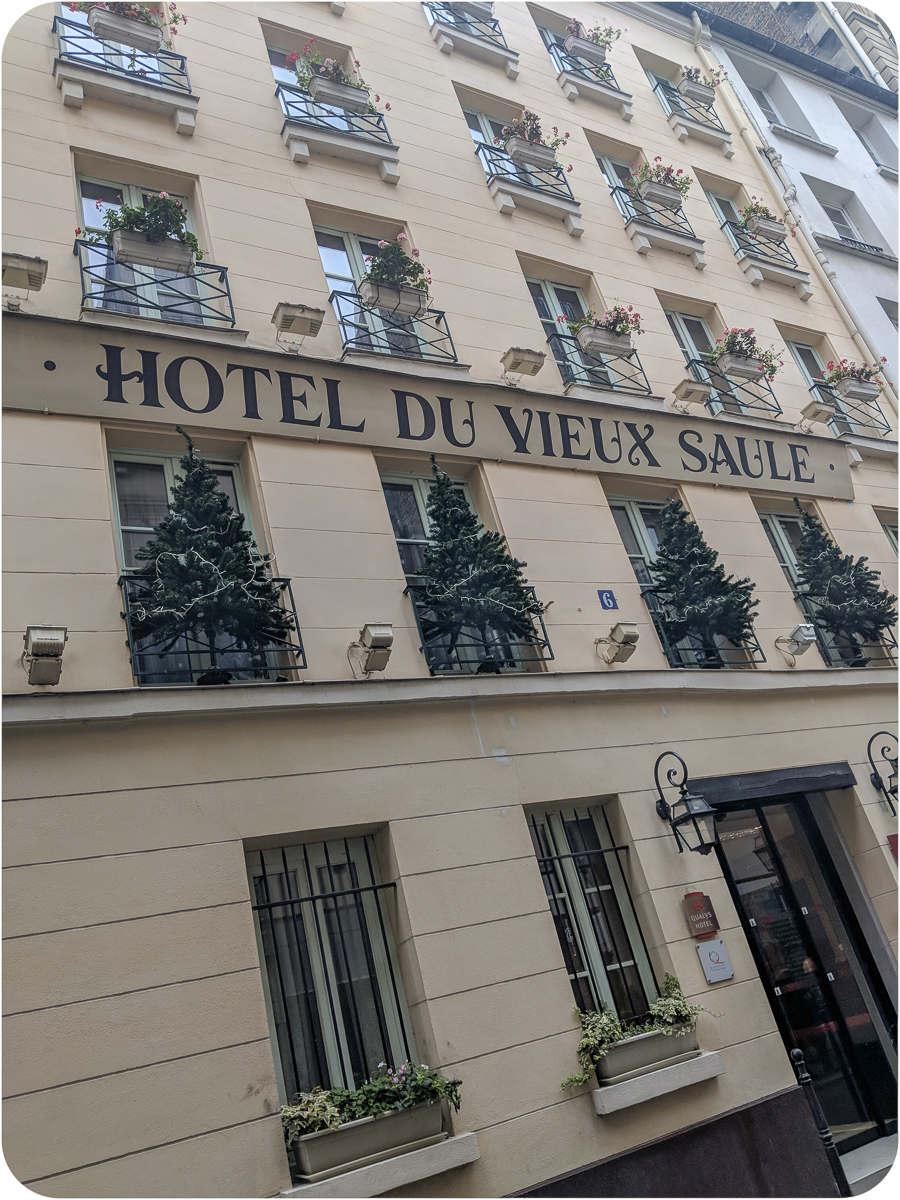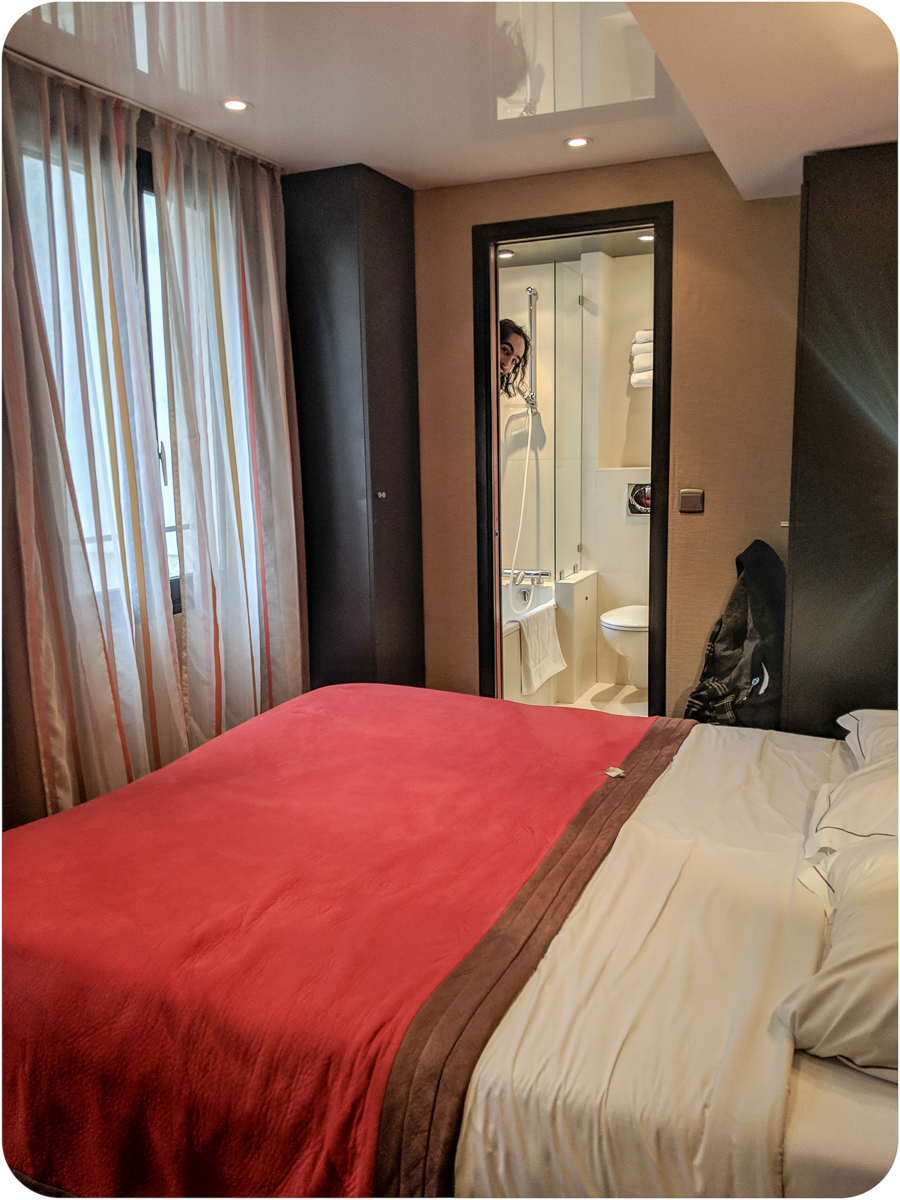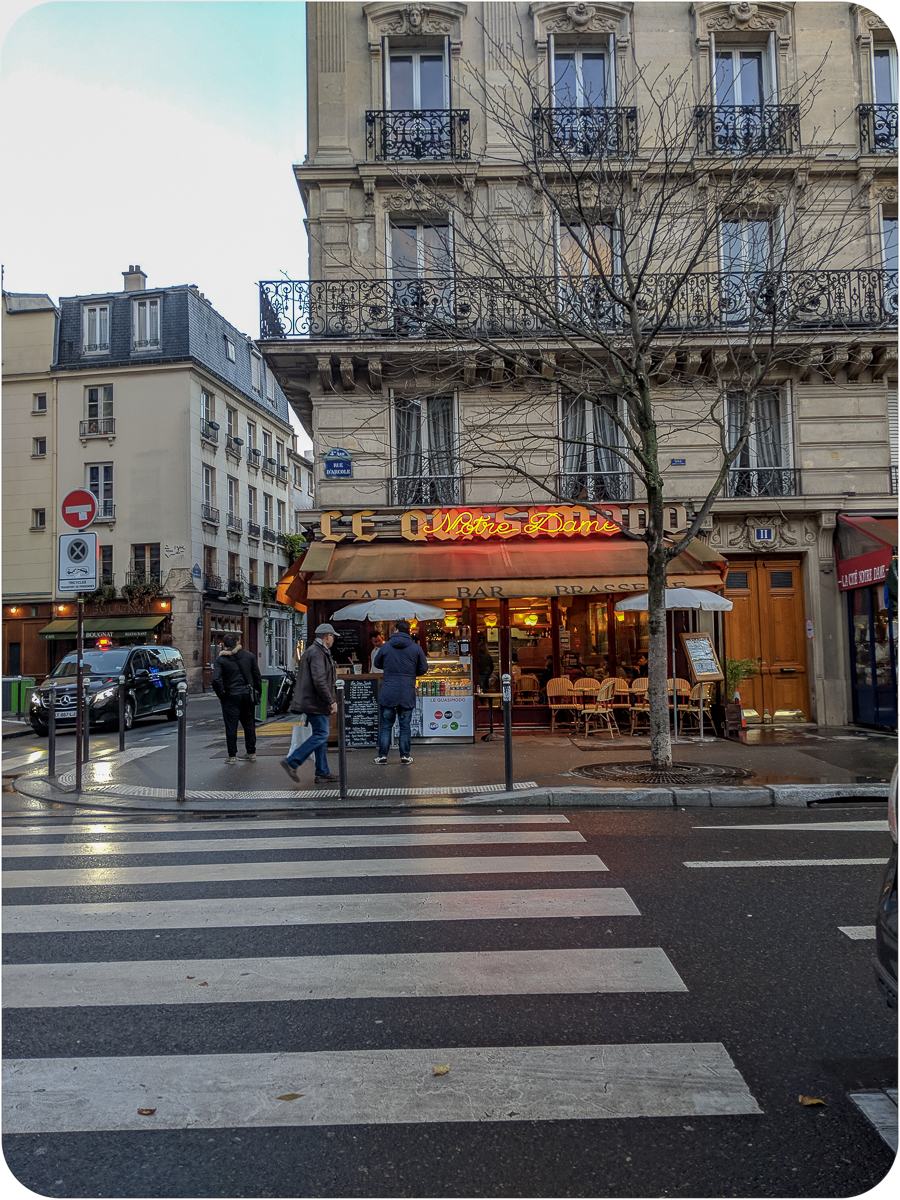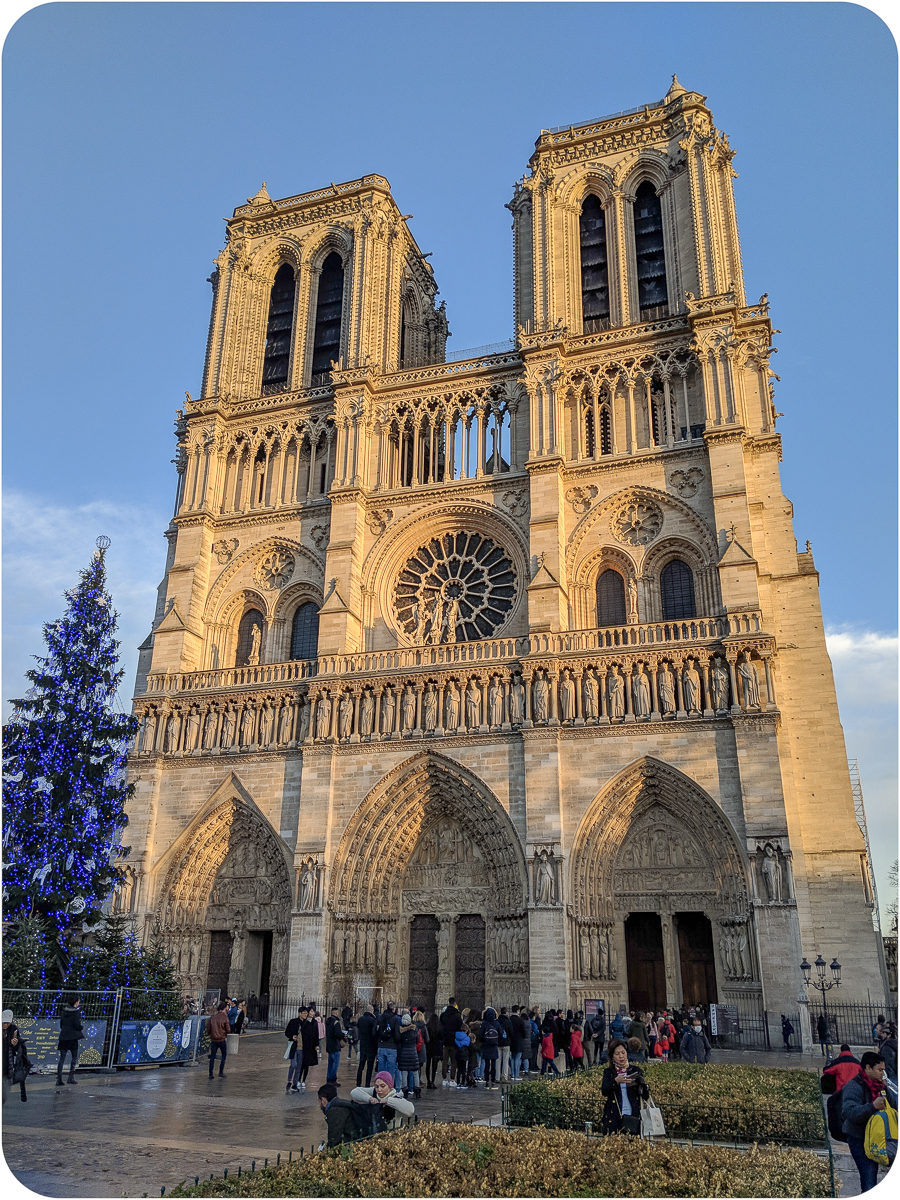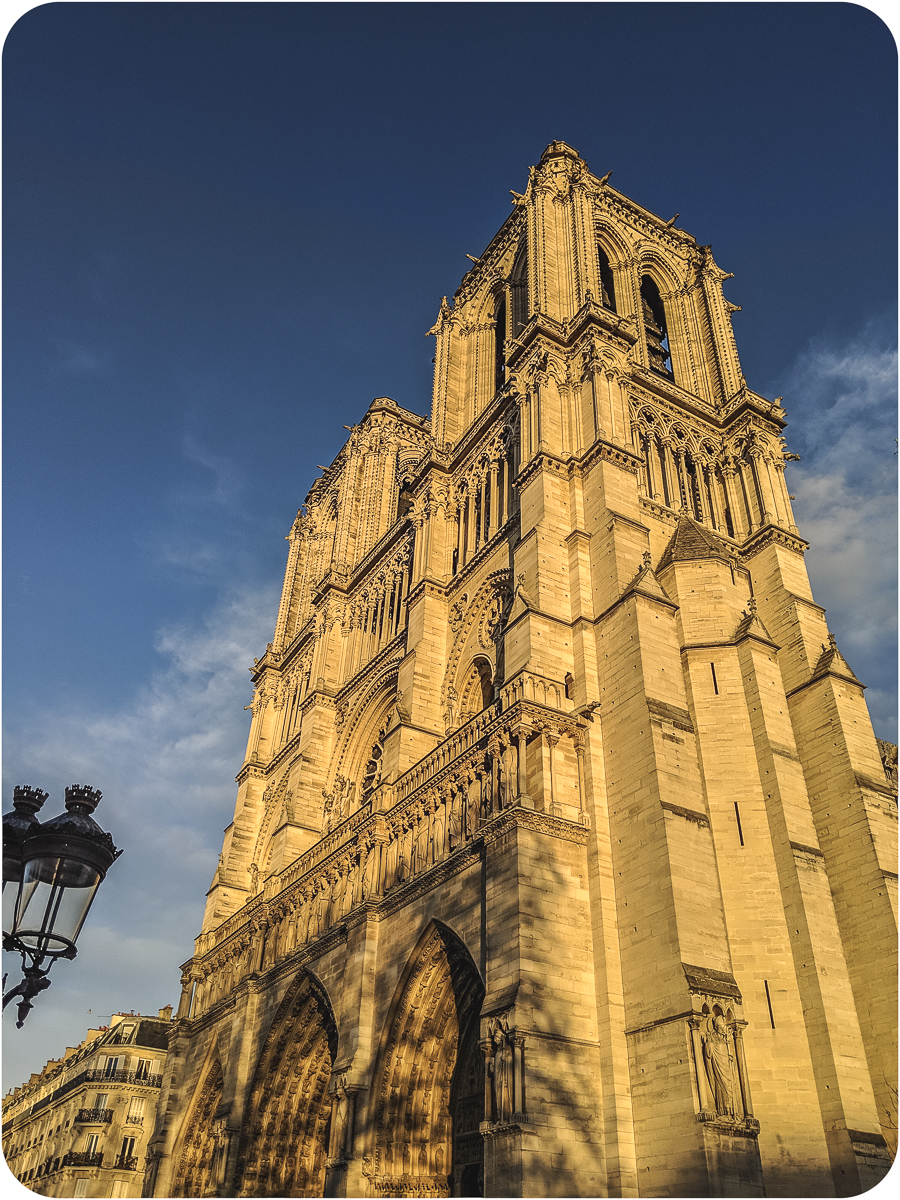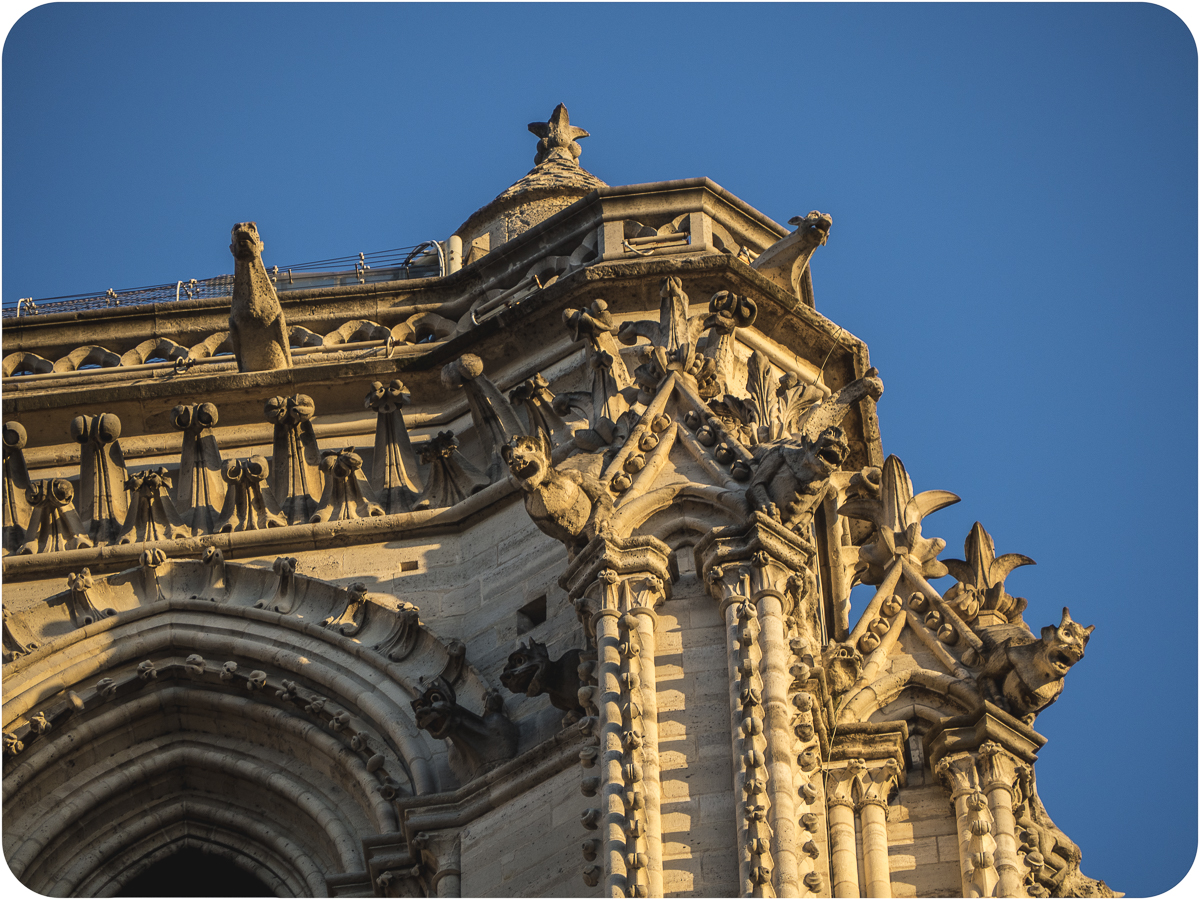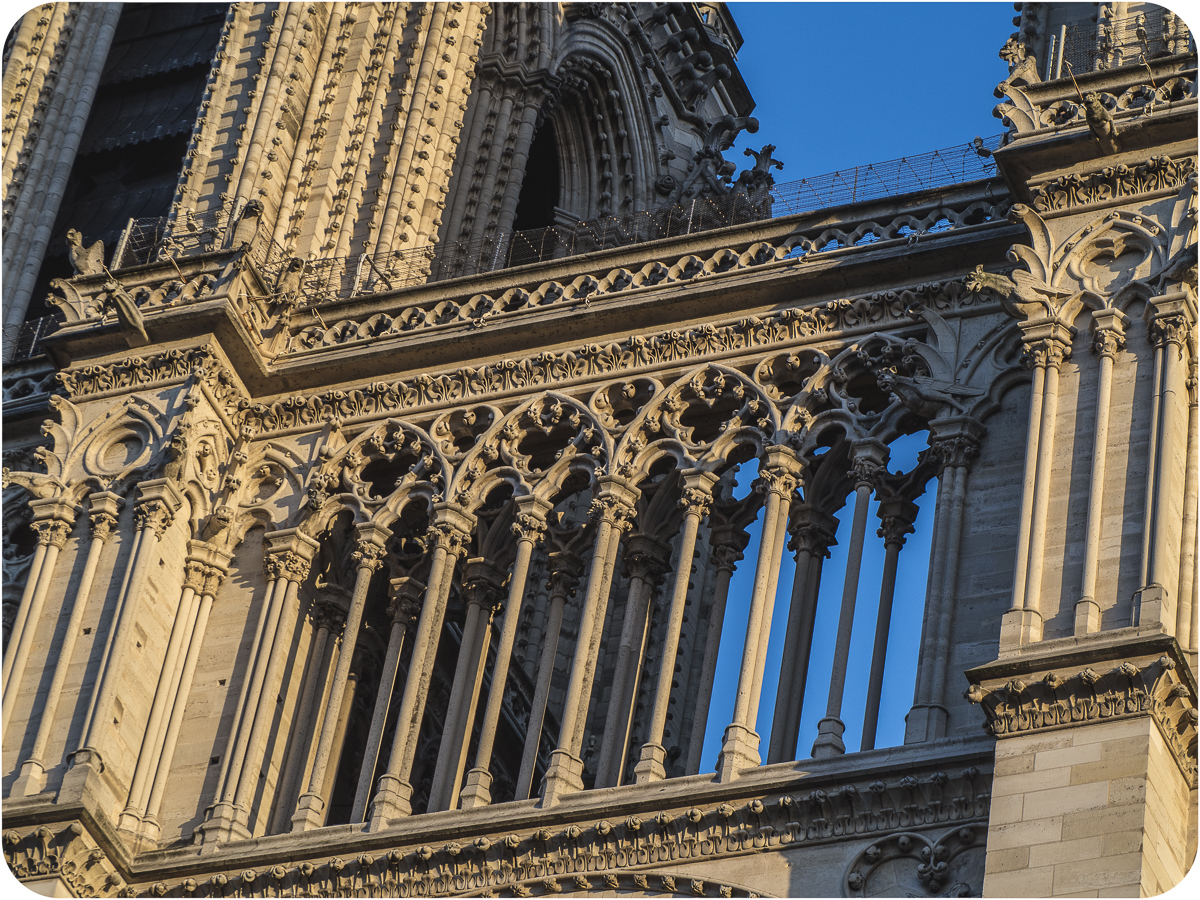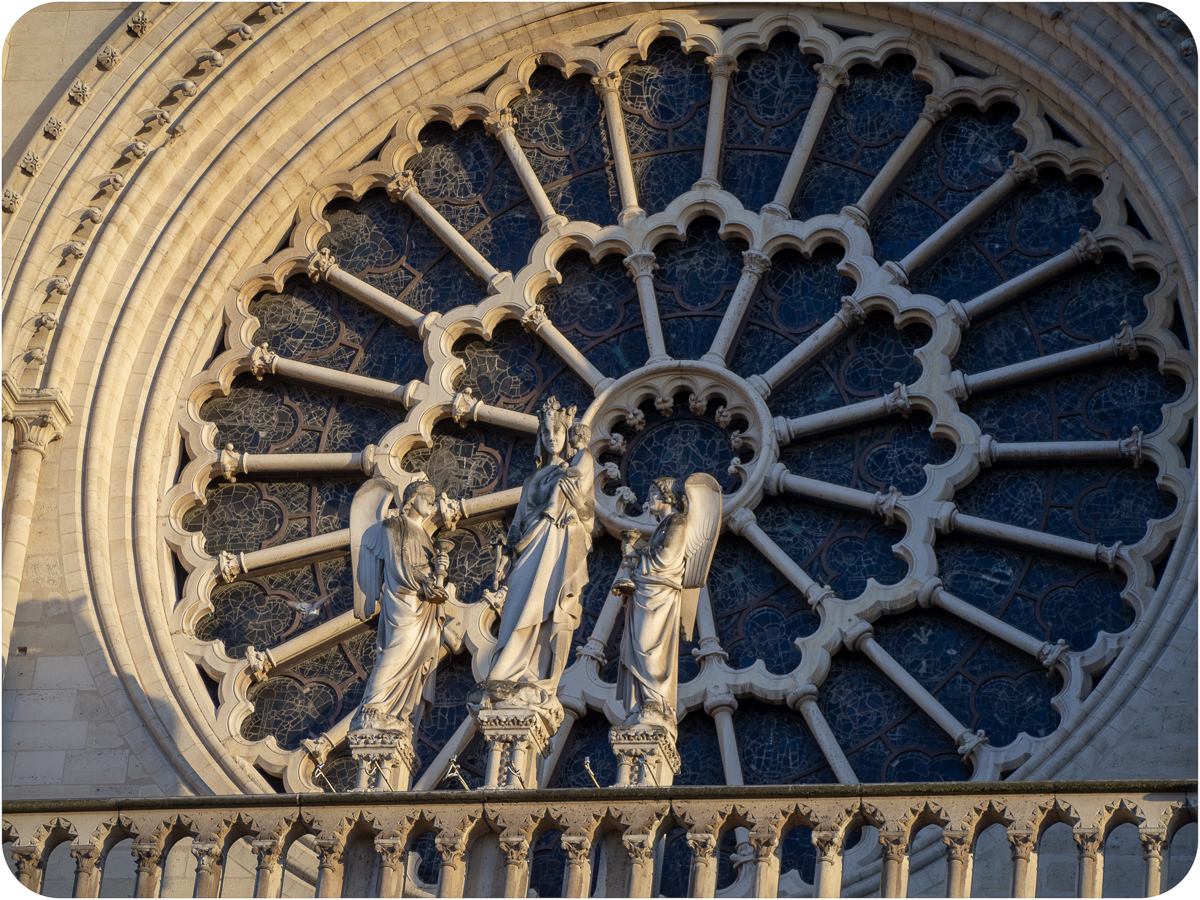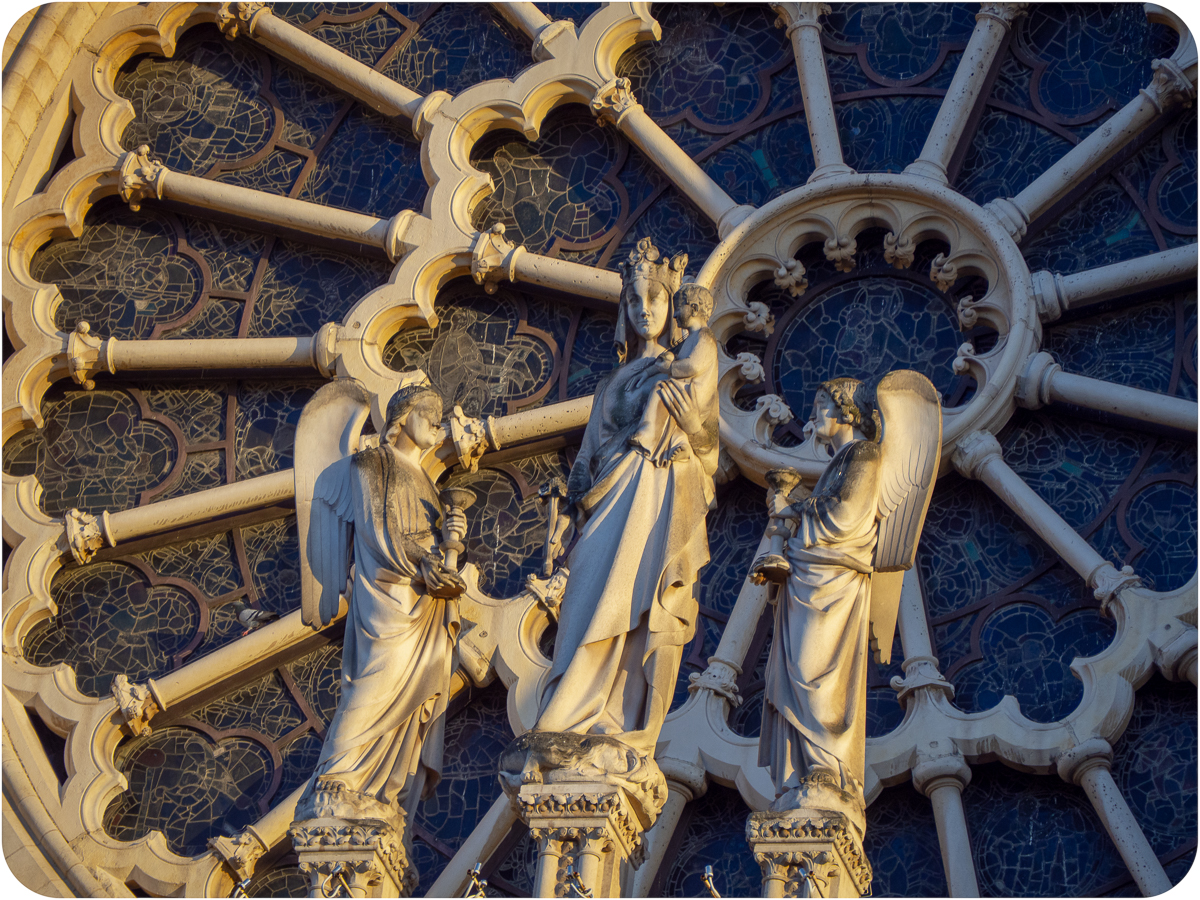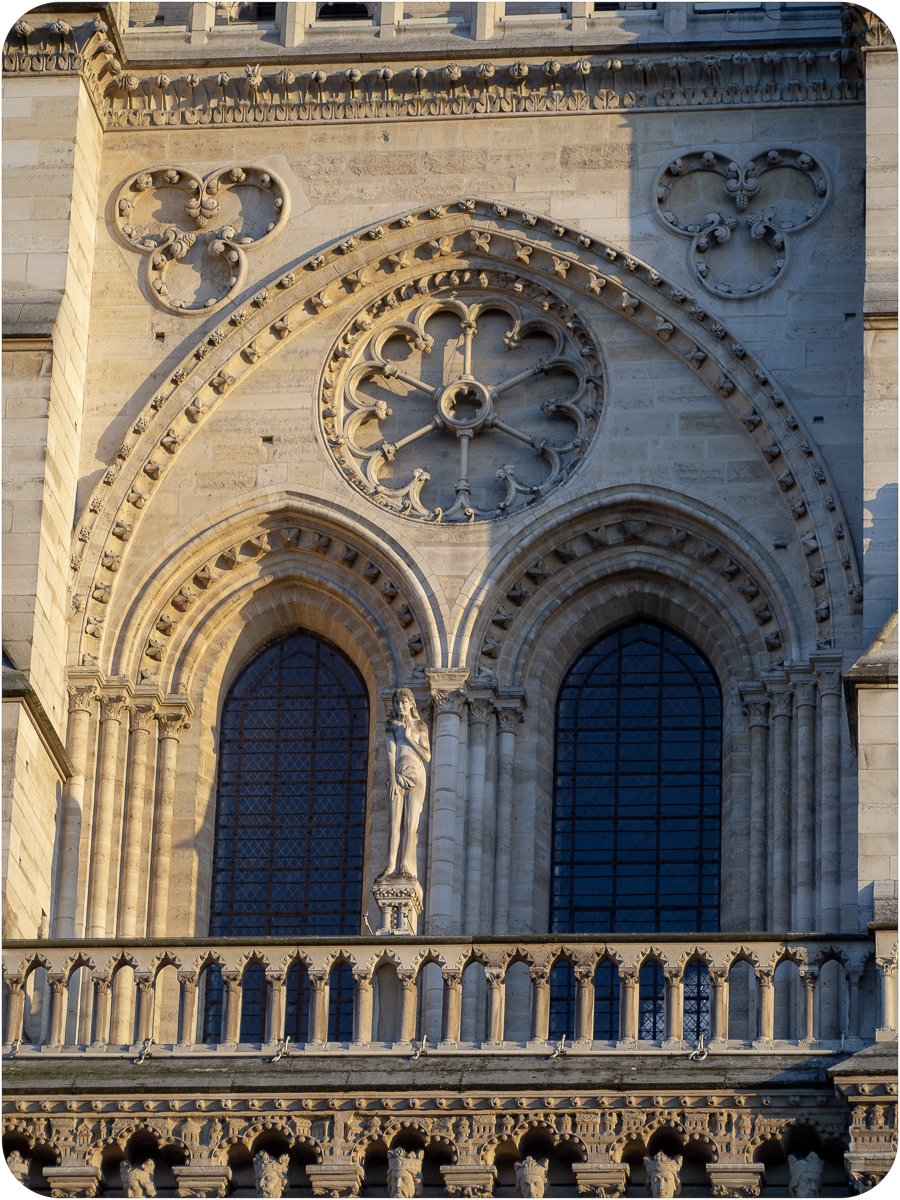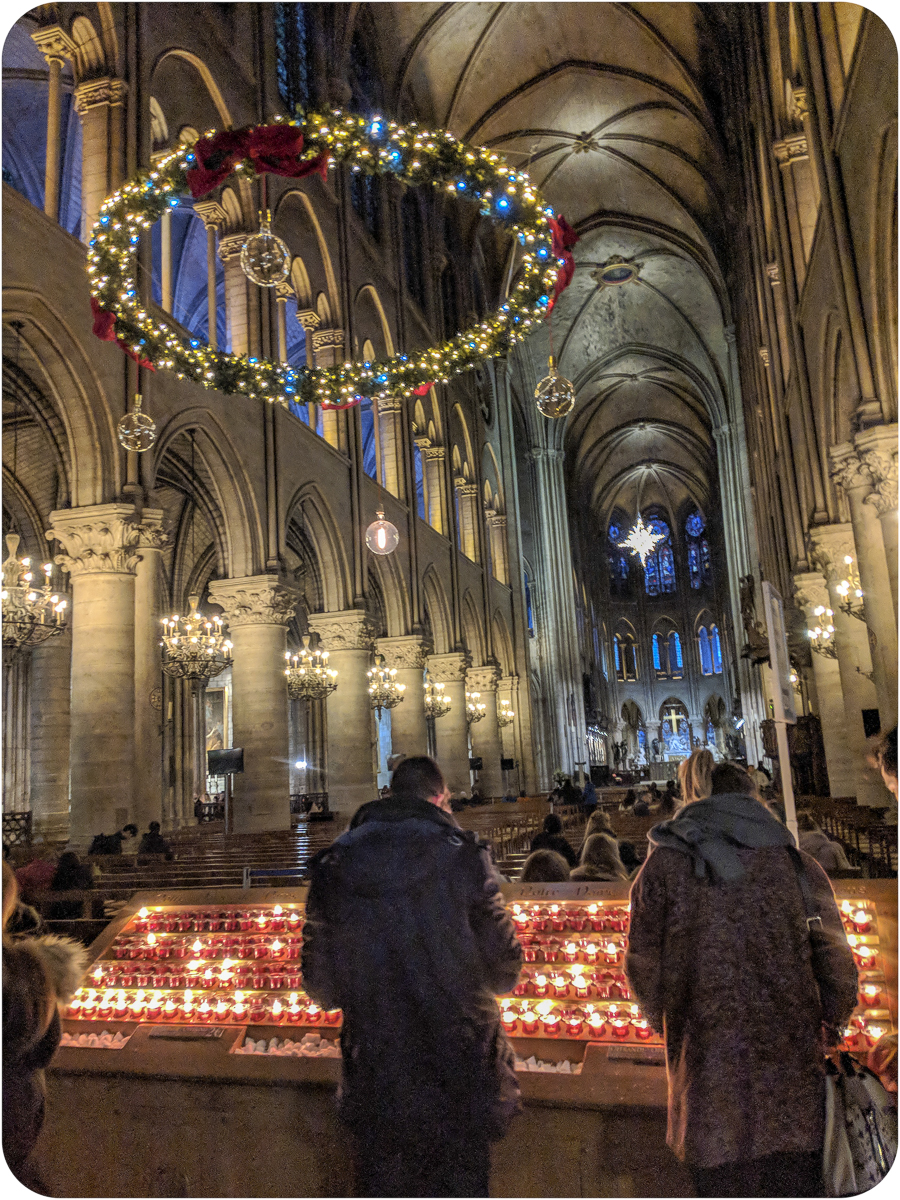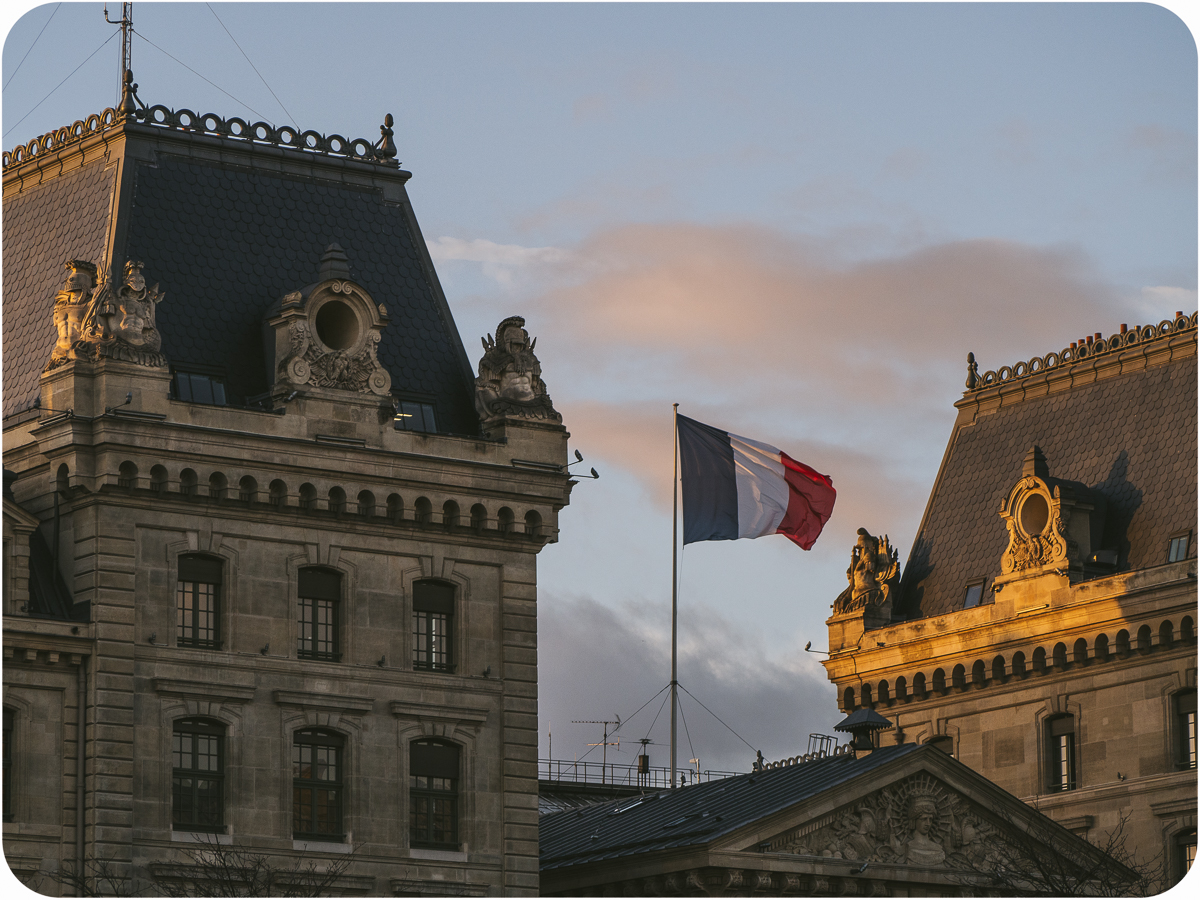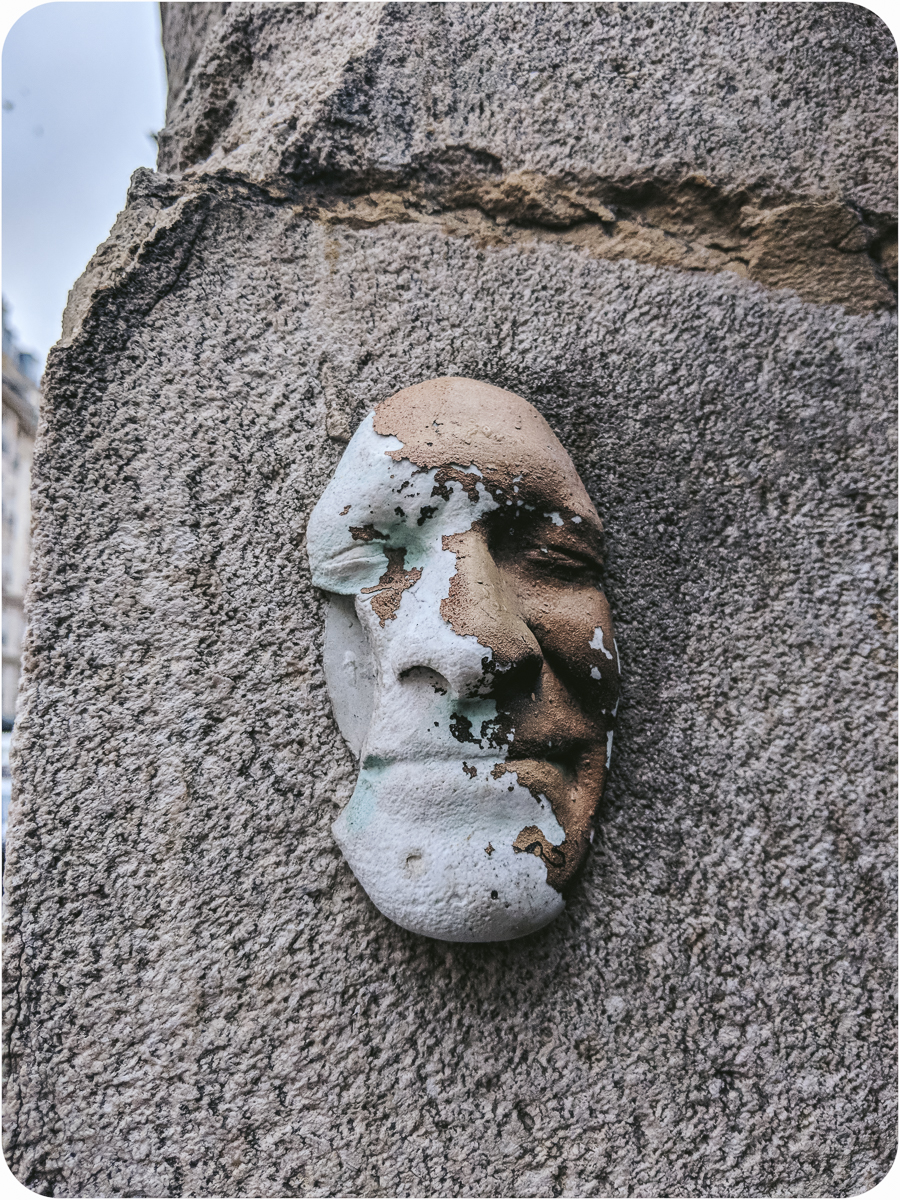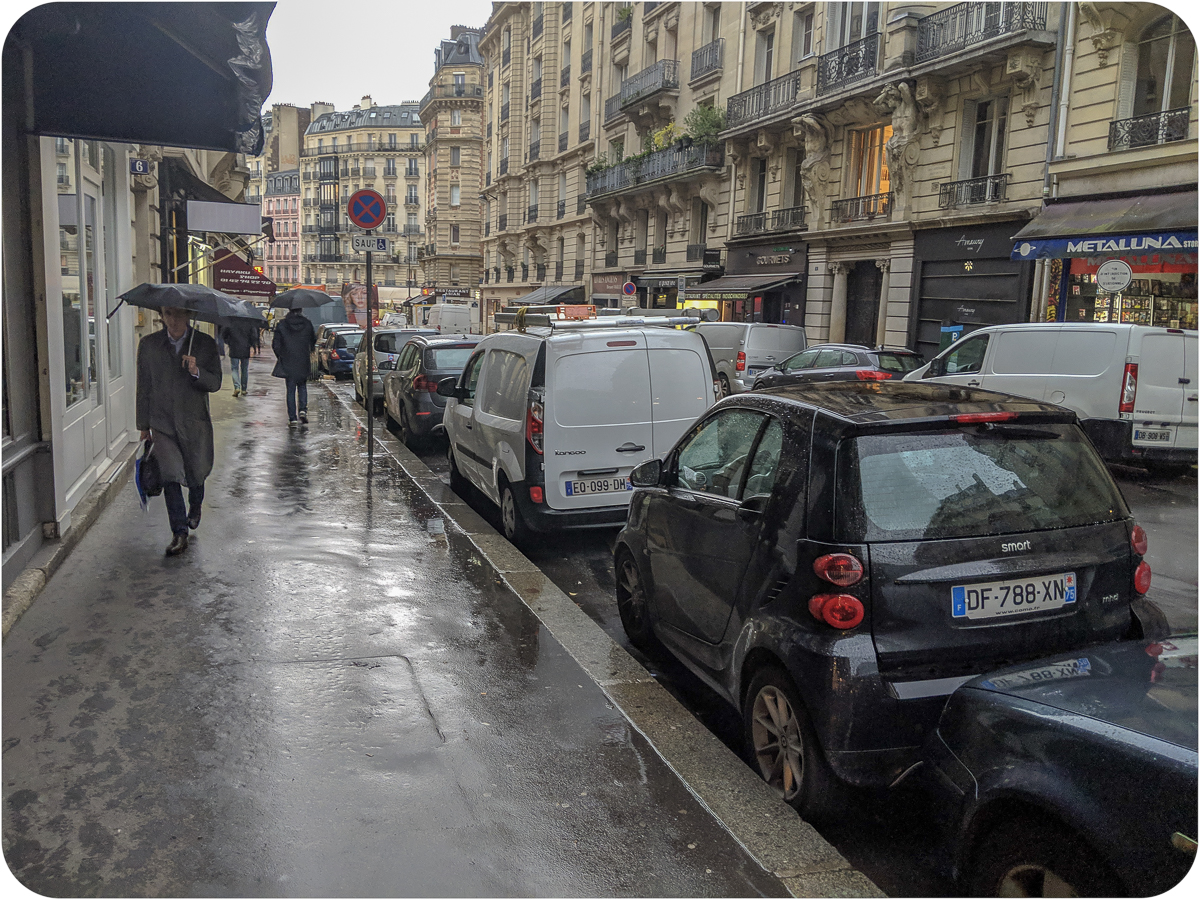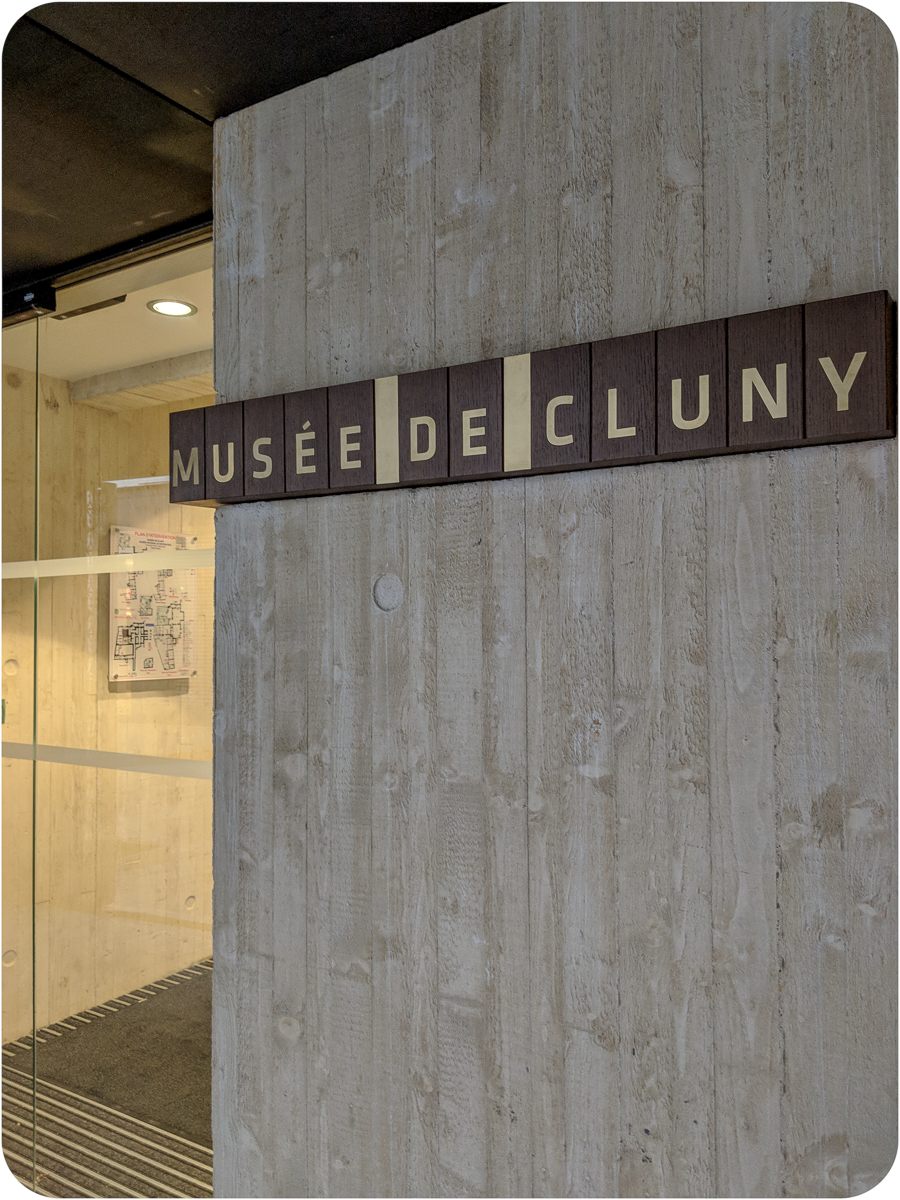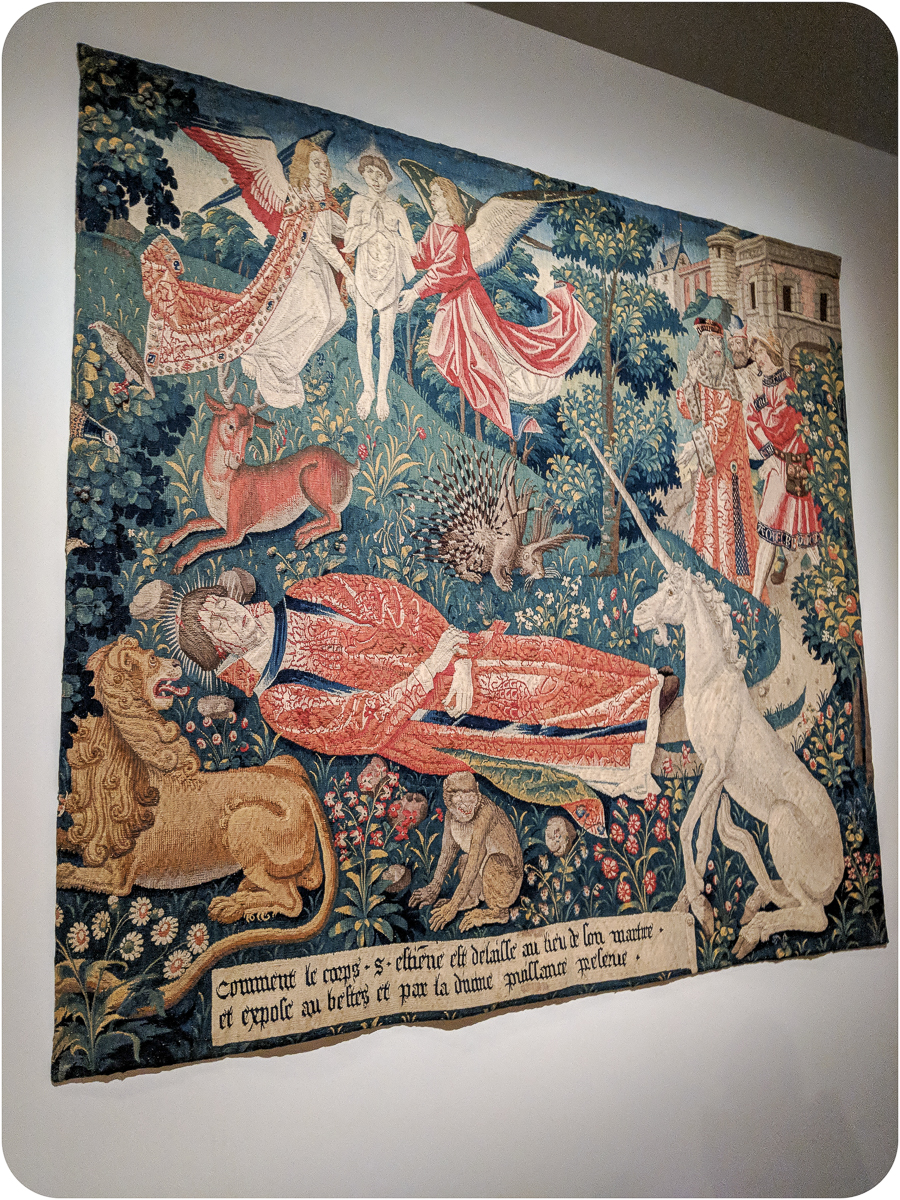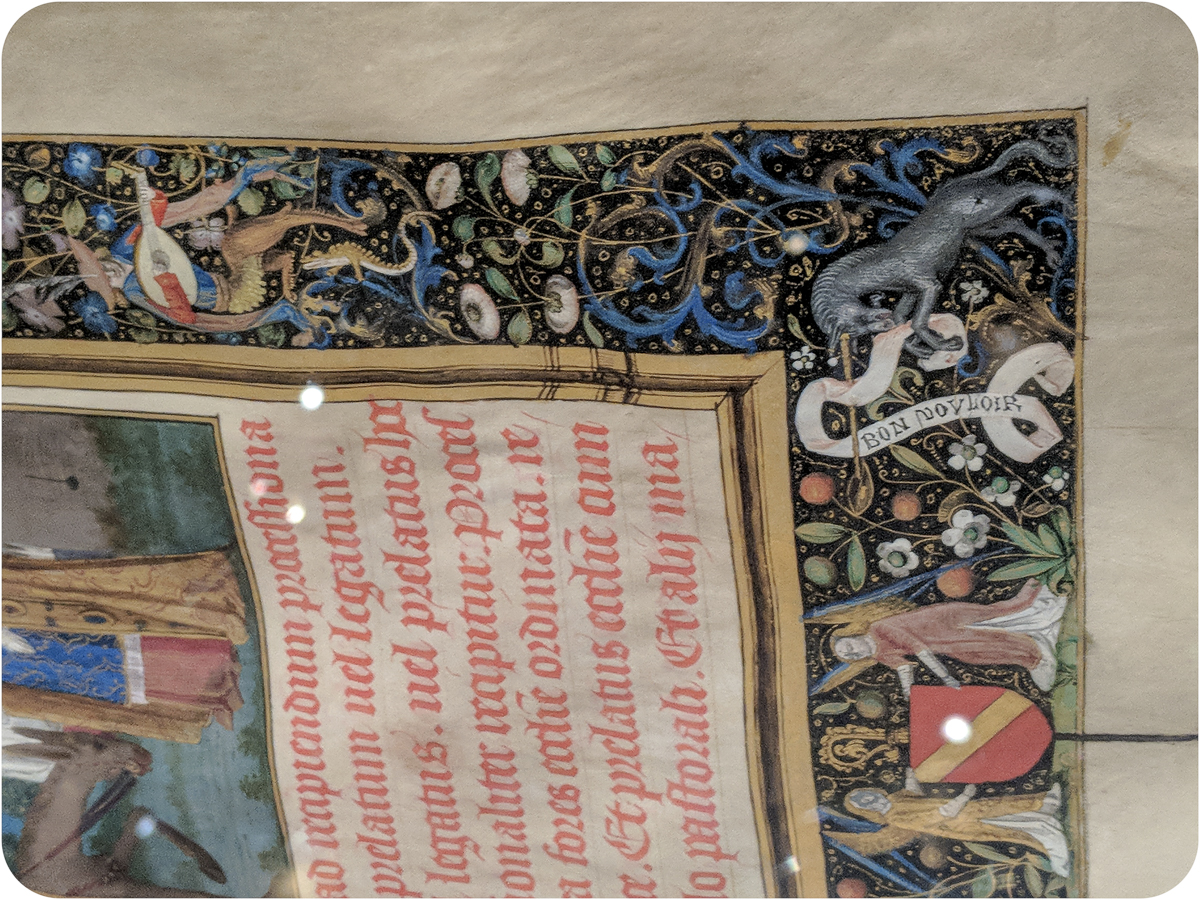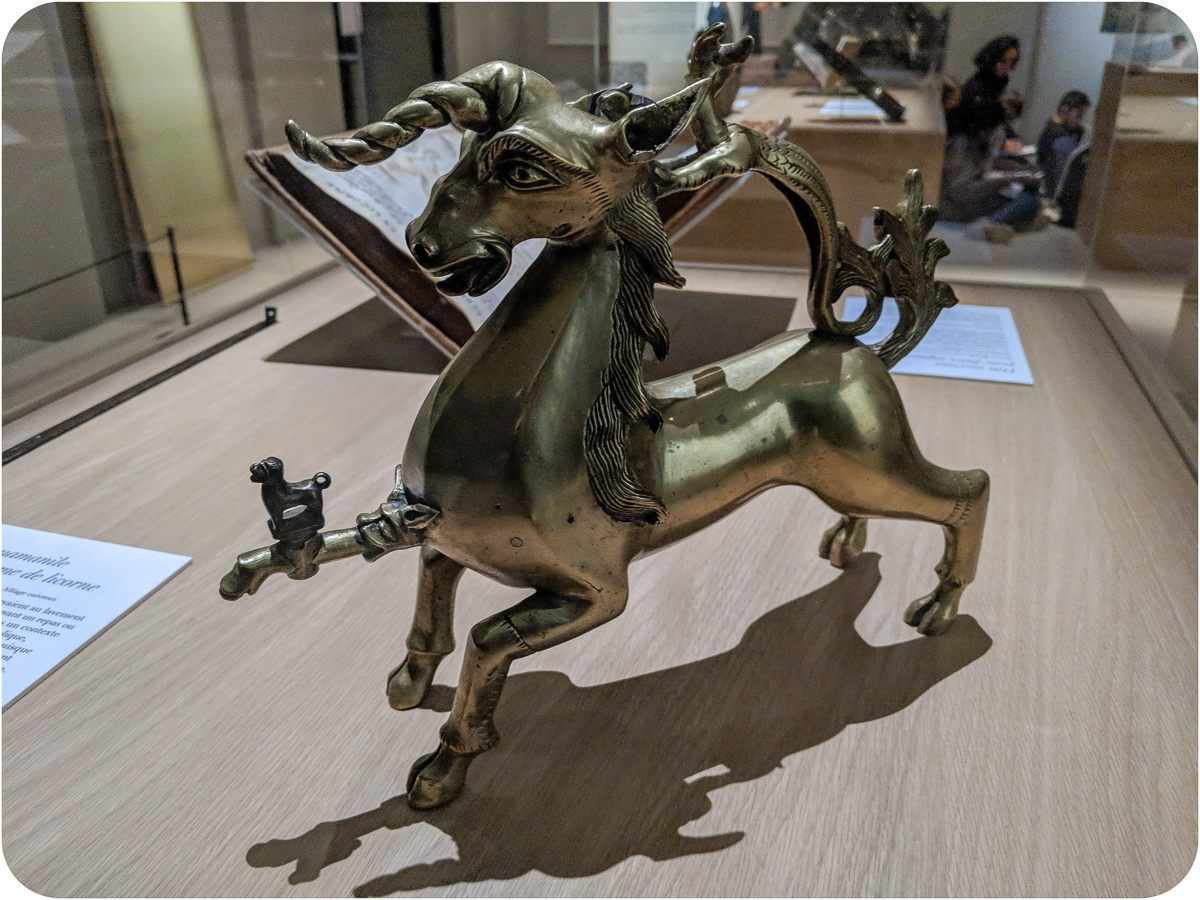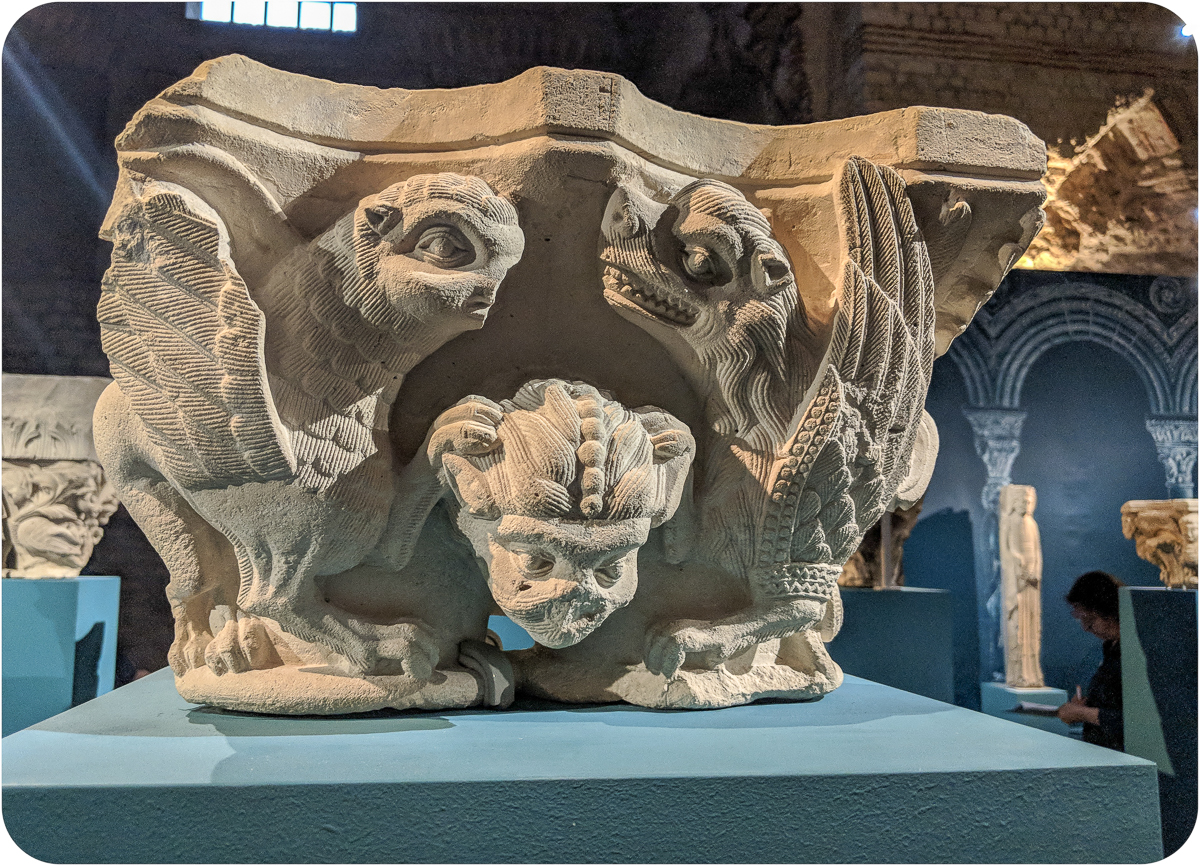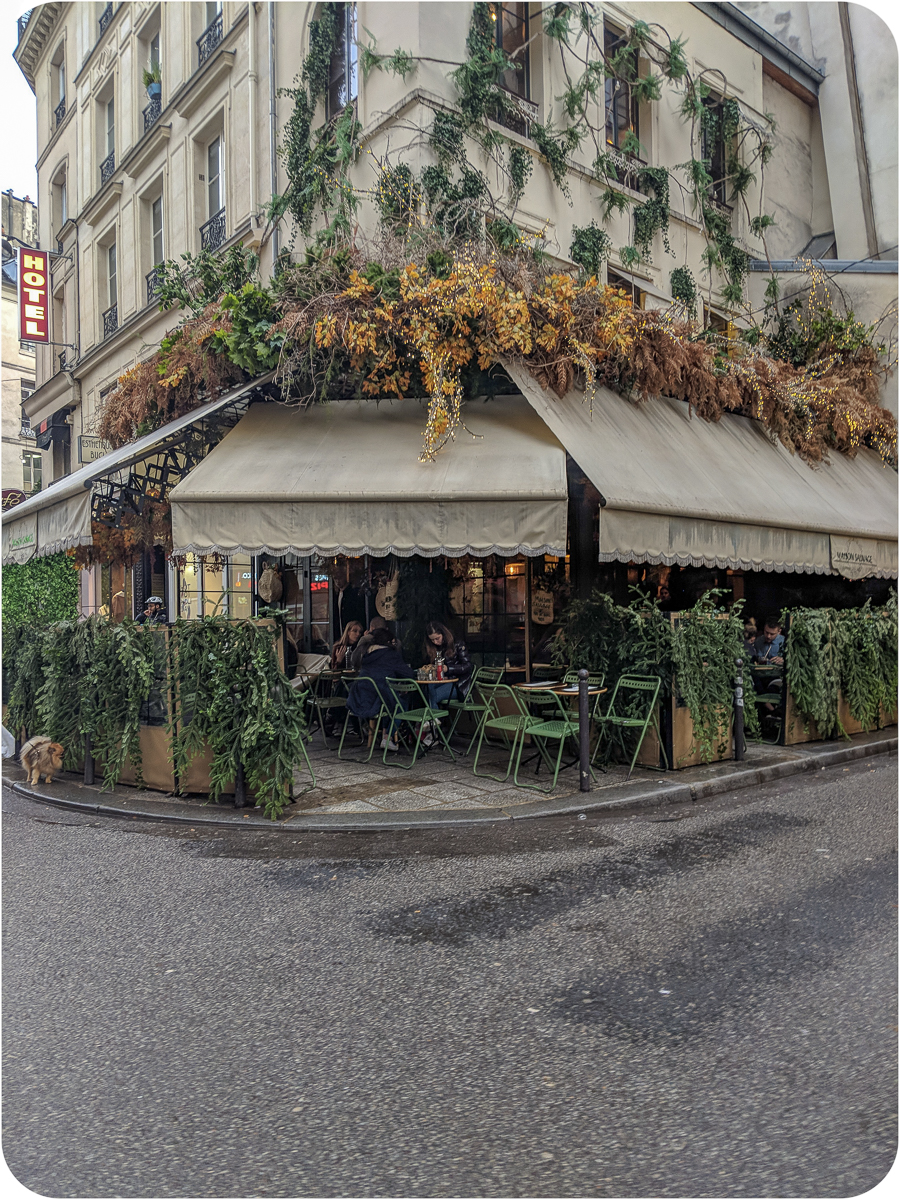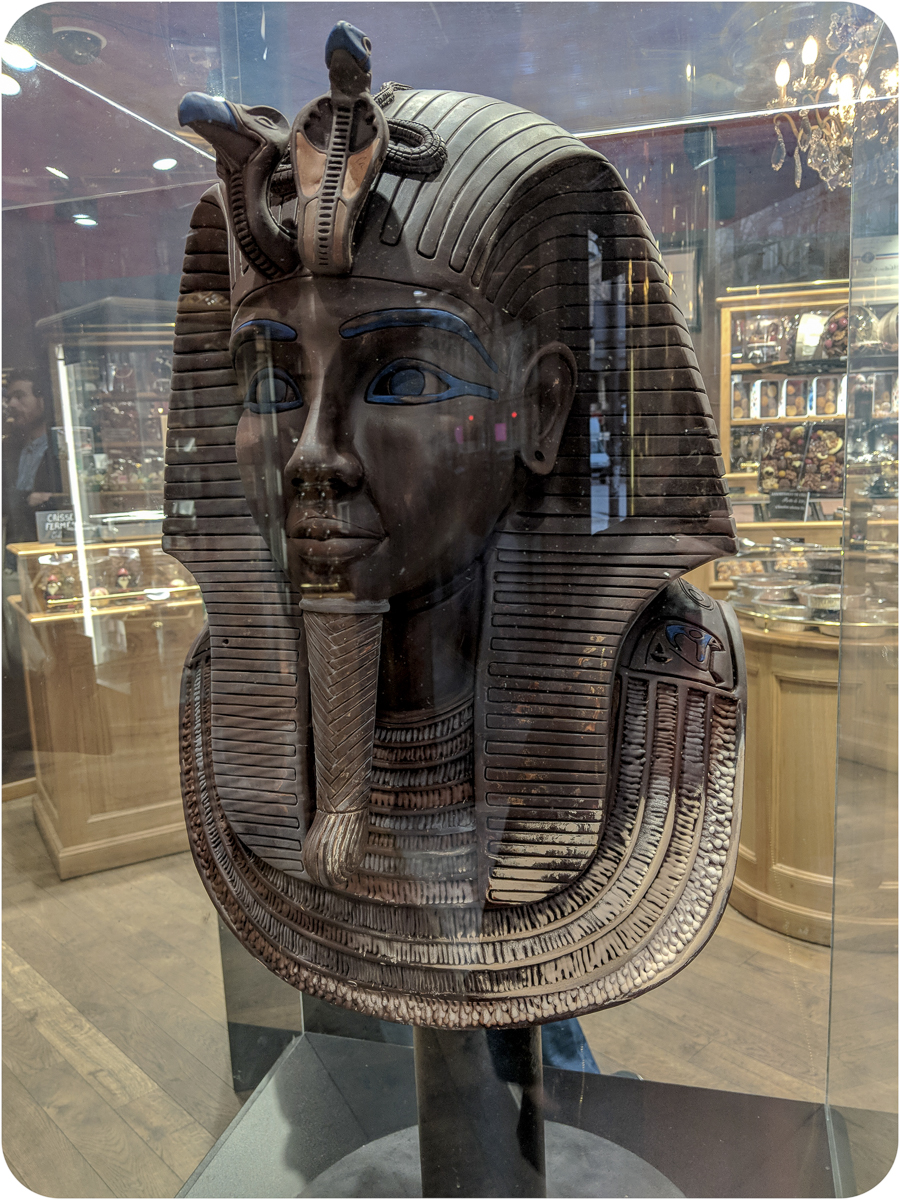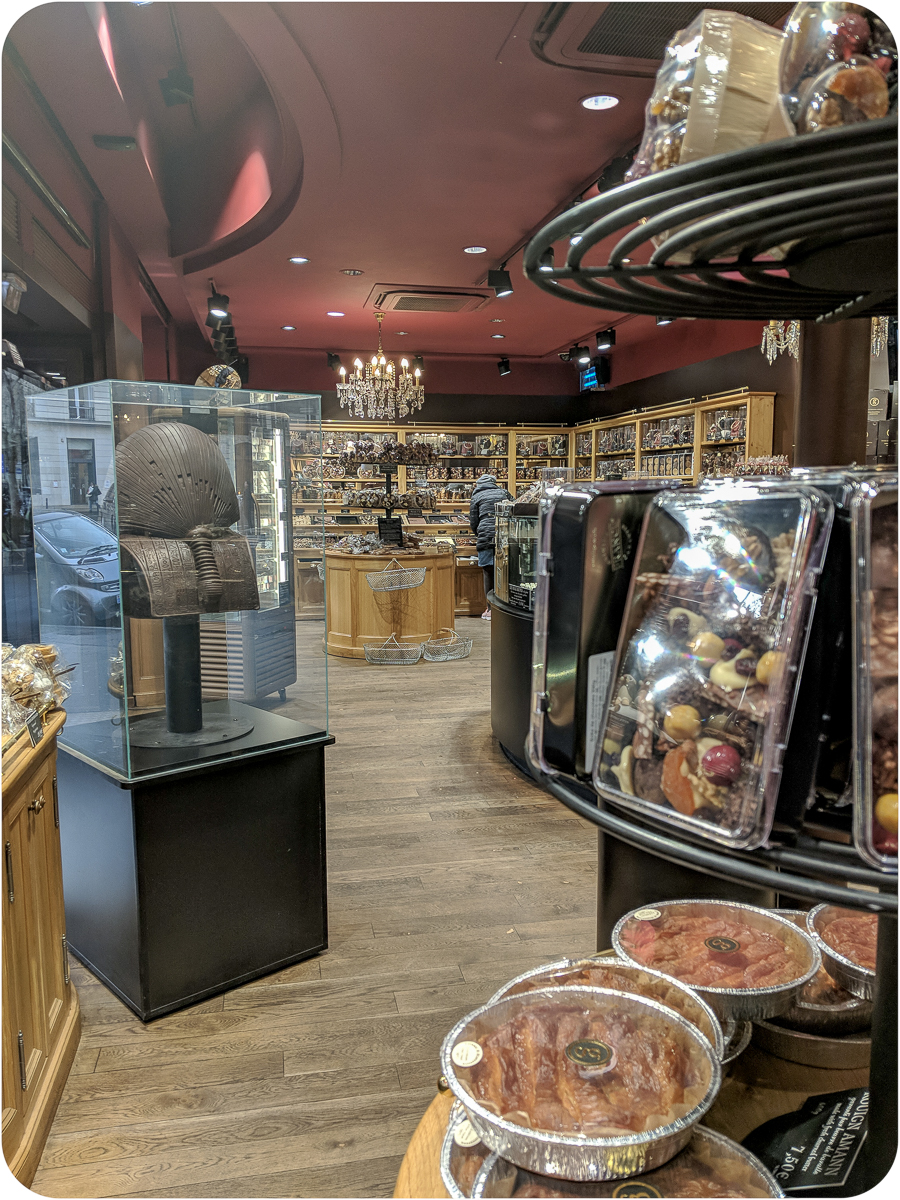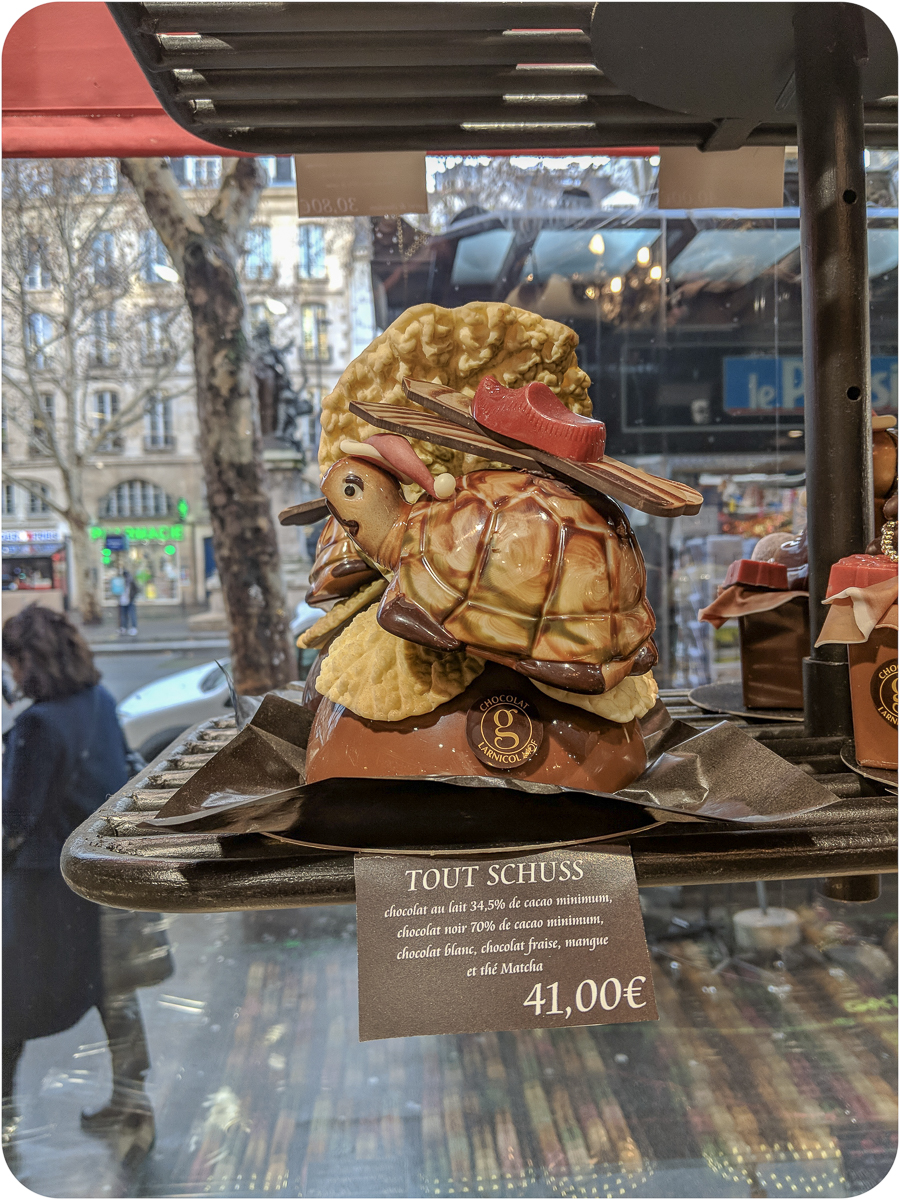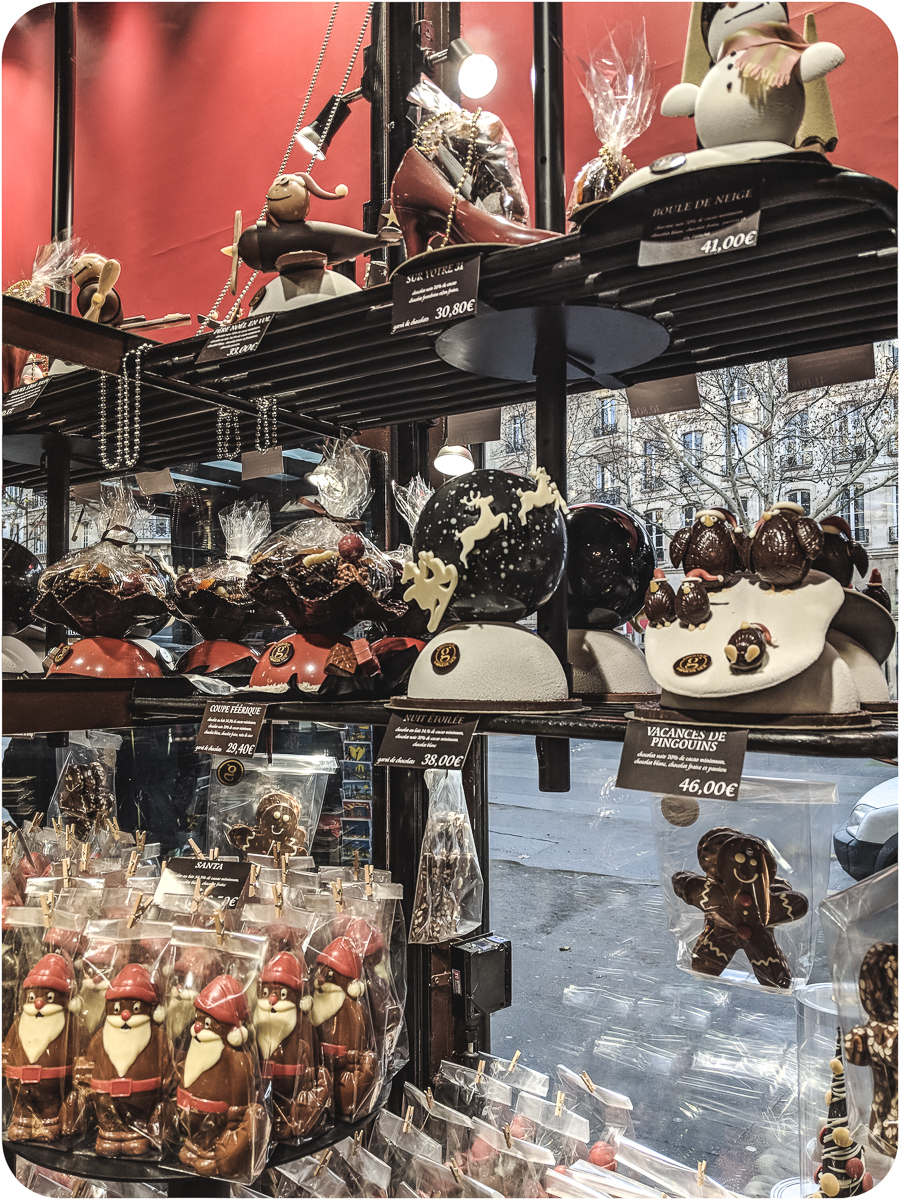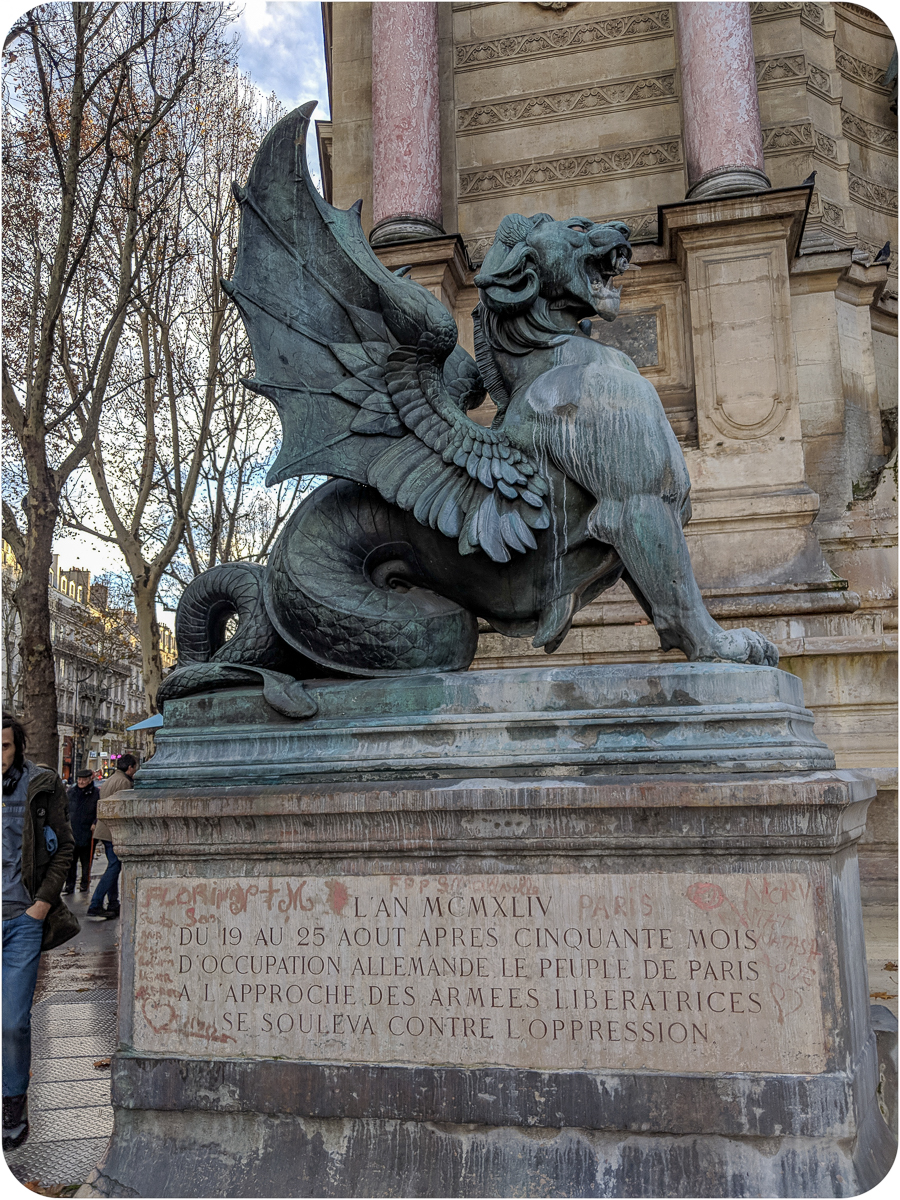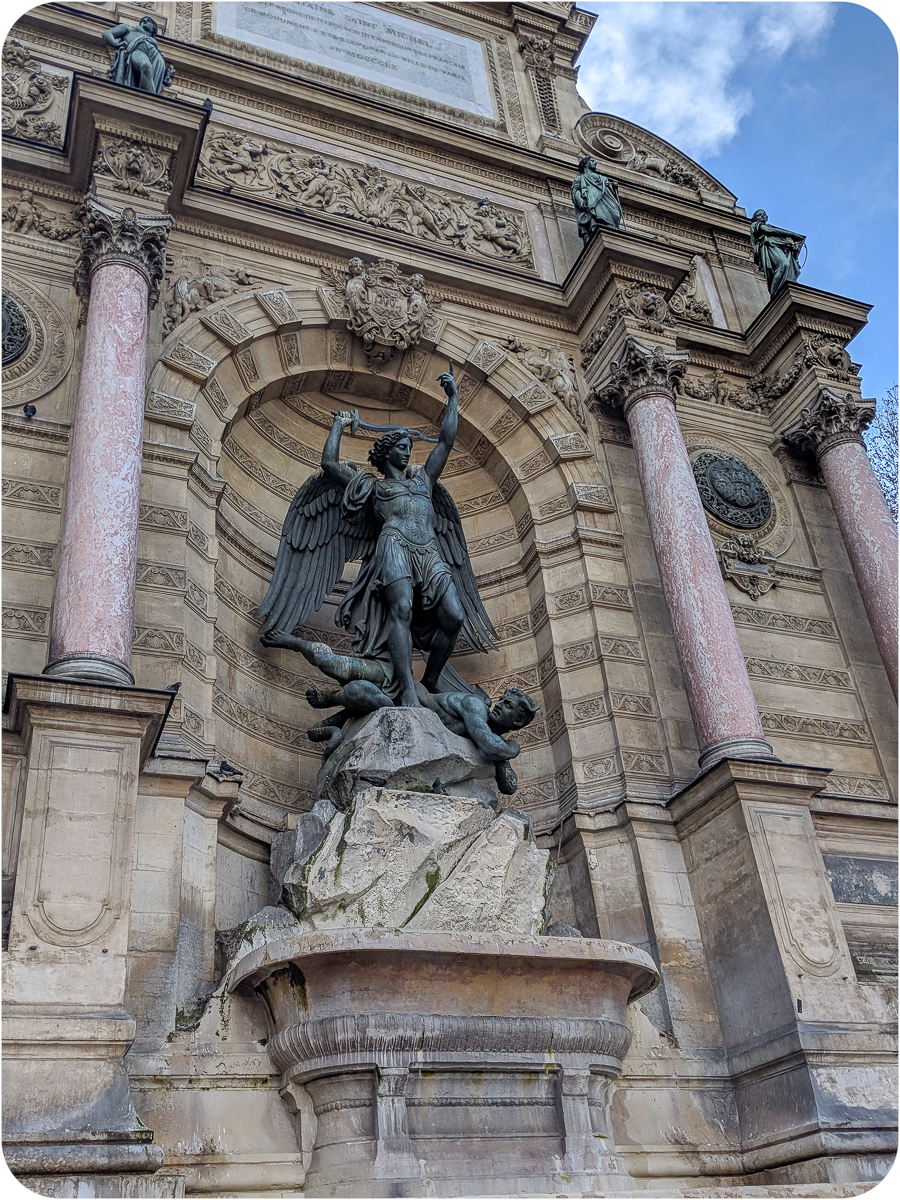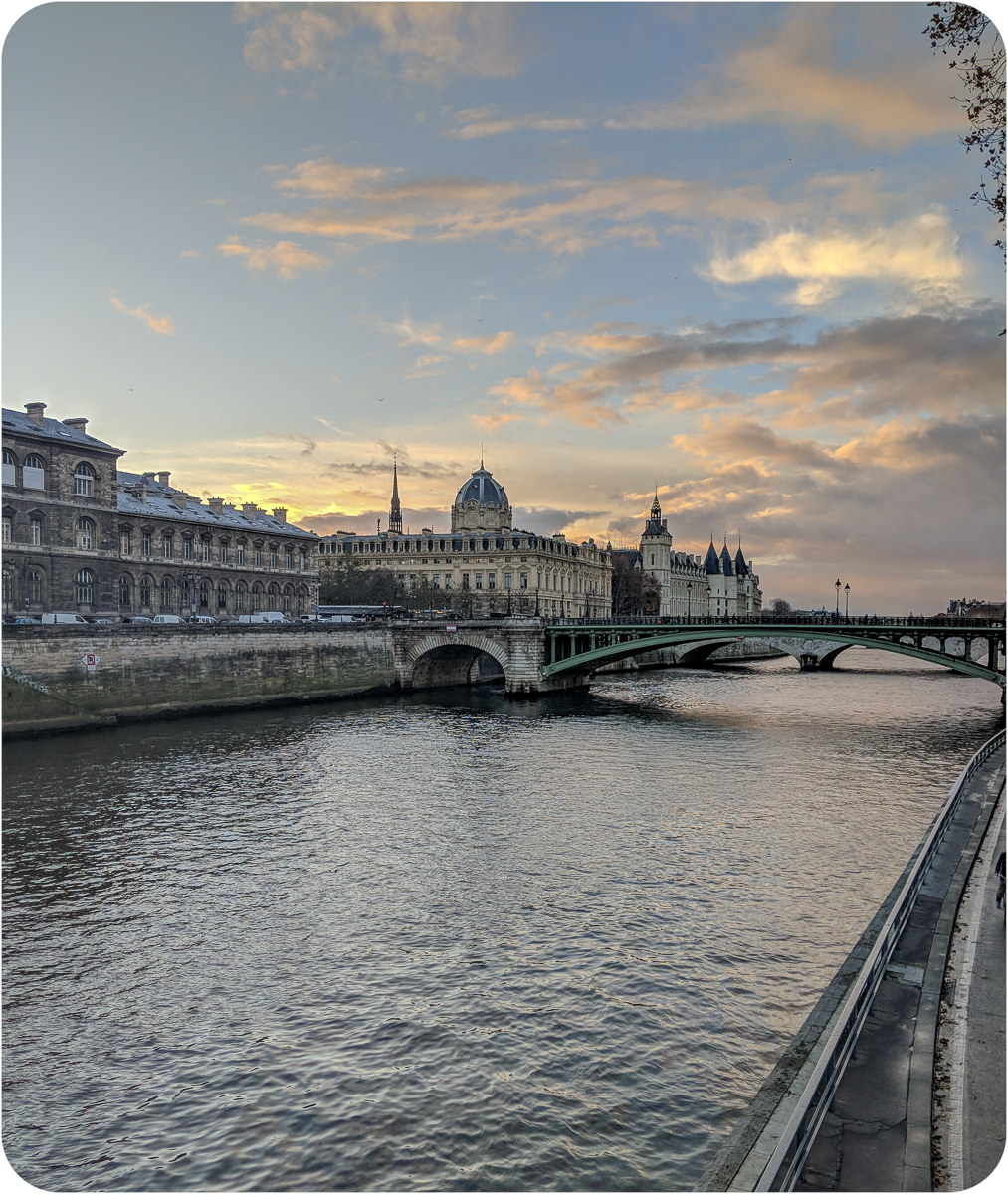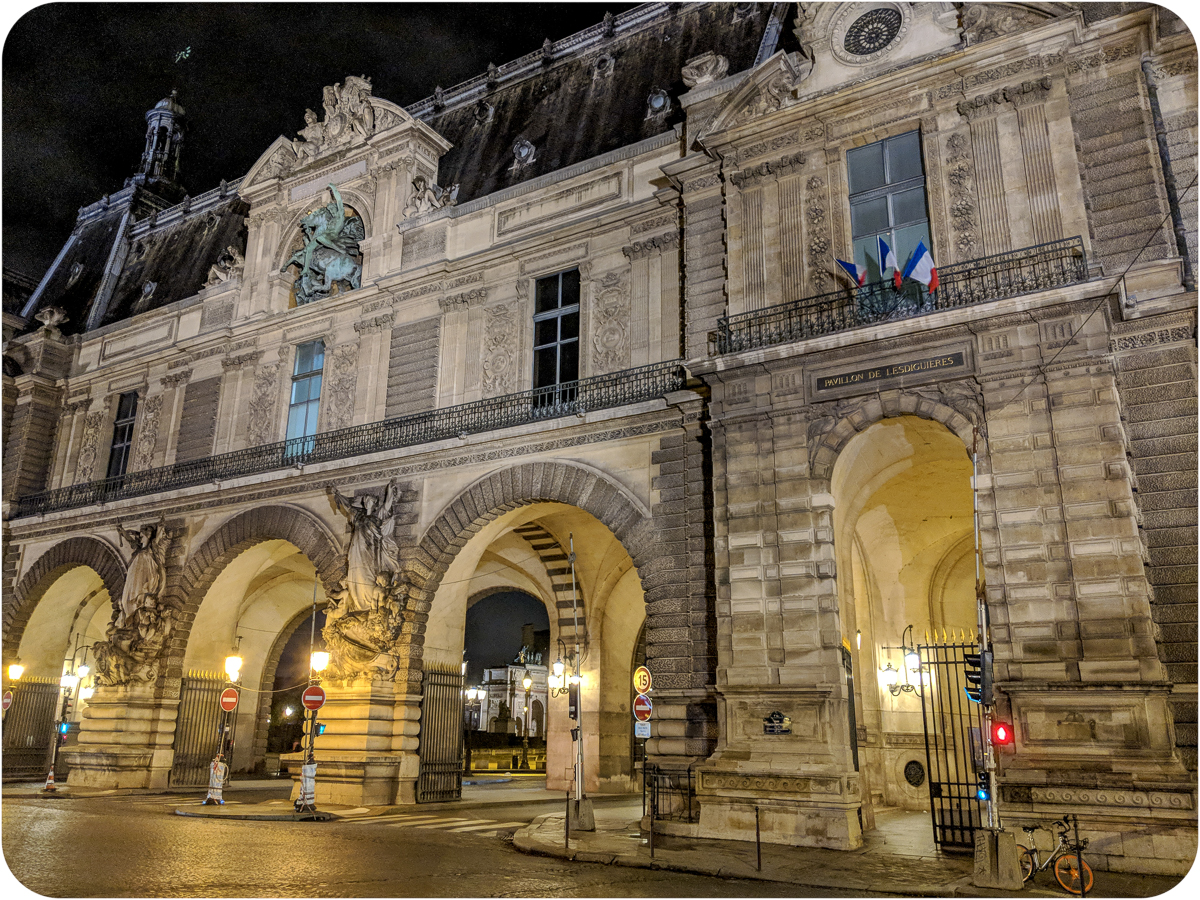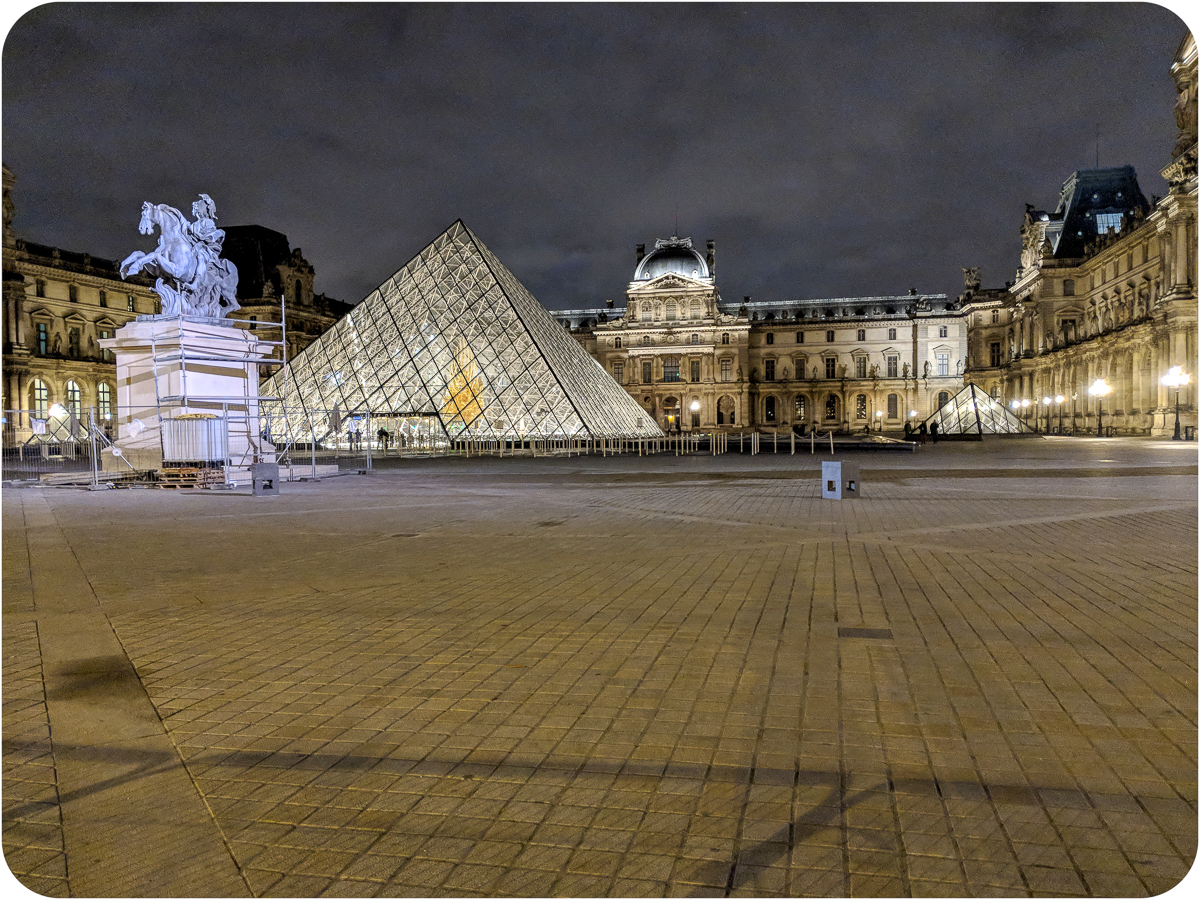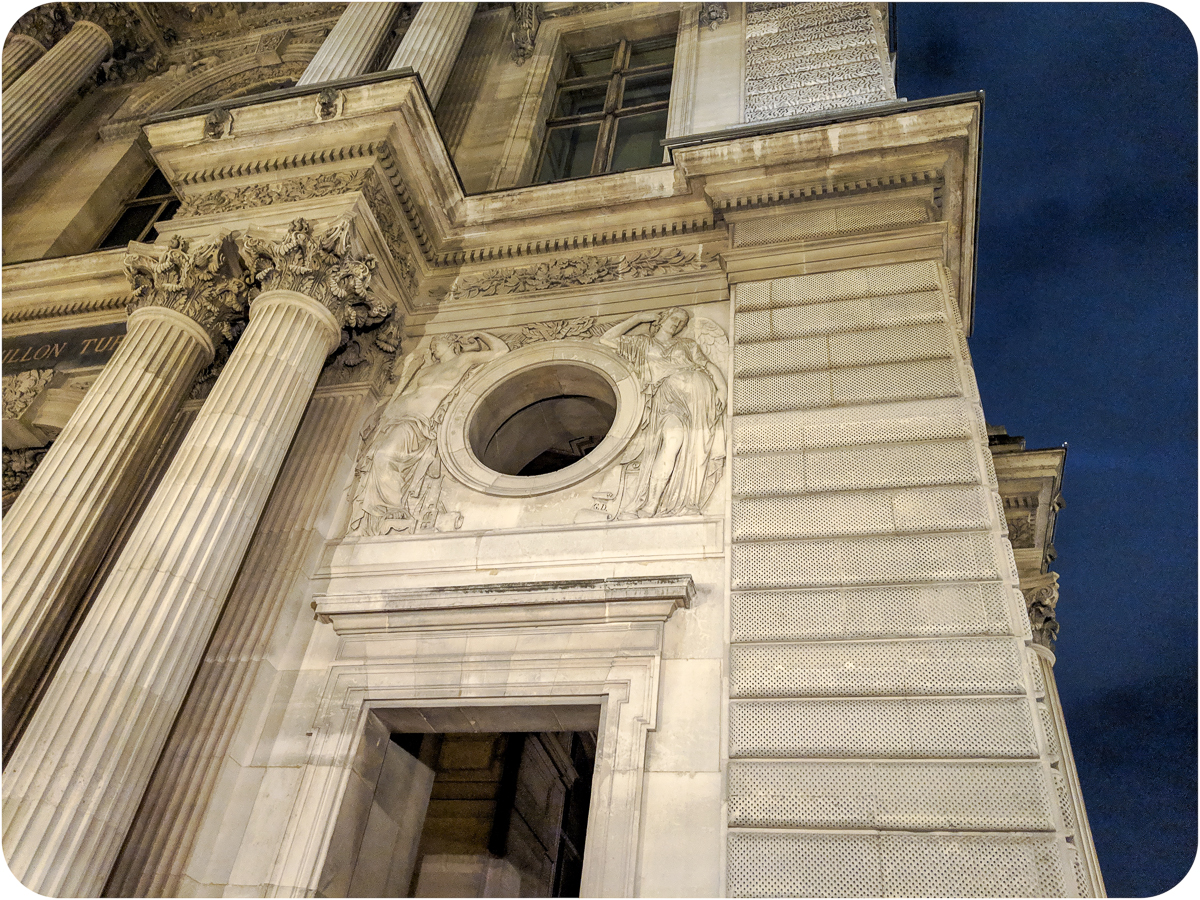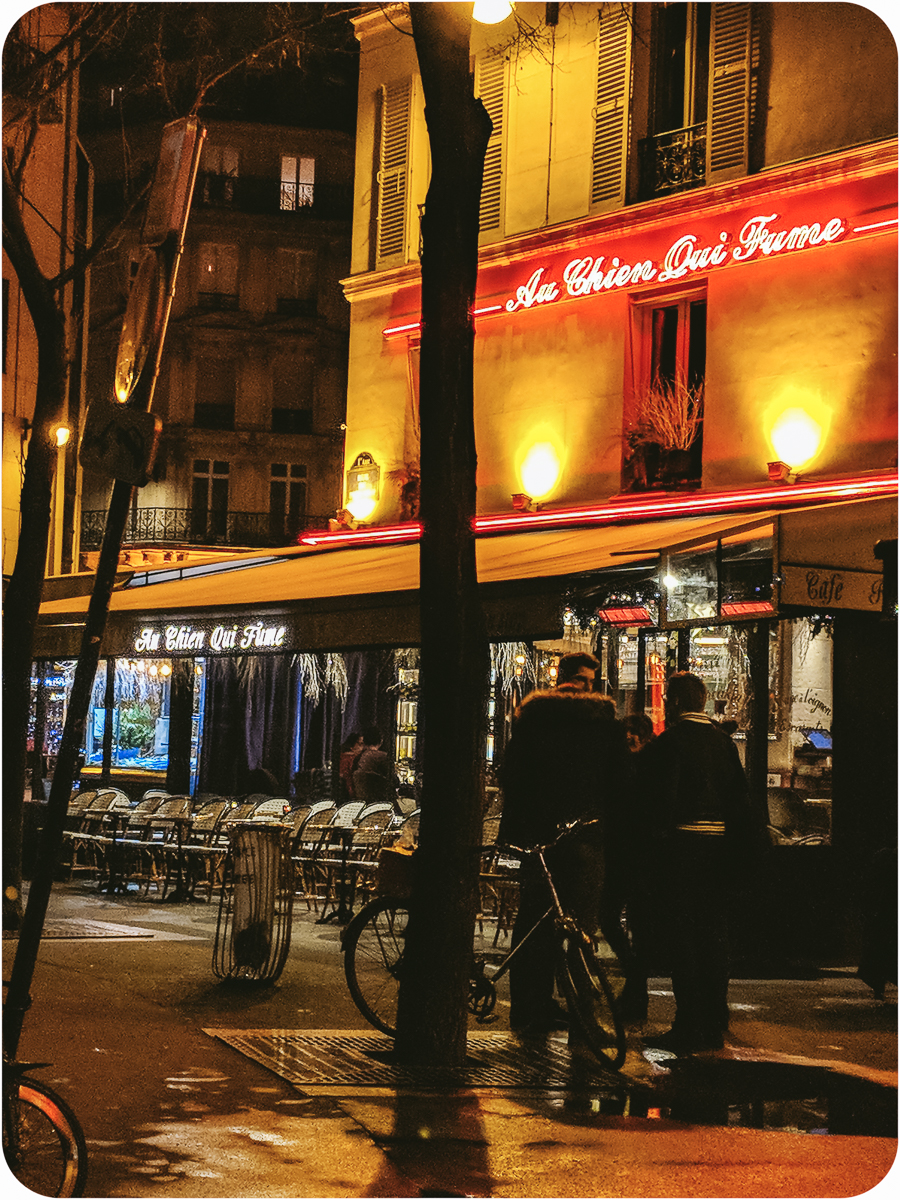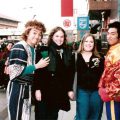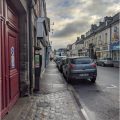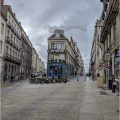Our first stop when we arrived in Paris was our hotel for the remainder of the trip, the Hotel du Vieux Saule, in the Marais neighborhood. Of all the hotels we stayed at, this is one I would say I settled on, after shifting the budget to accommodate the palace-adjacent properties we stayed in earlier in the trip. When I think back, while I can’t say it with 100% certainty, this place springs to mind as the most likely candidate responsible for our brush with bedbugs and the deep cleaning frenzy* that ensued afterward.
Why do I point the finger in their direction? Given that I had many bites on different parts of my body, I have to assume that there wouldn’t have been enough time for it to take place on public transit (Through my winter coat? Not likely.), or really even any place where I was staying only one night. The only other hotel we stayed in more than one night was in Nantes, and just statistically based on population, it’s more likely that the Parisian hotel had bedbugs than the one in Nantes. Also, when we checked in, there was a half-consumed beverage and garbage in the minibar and some pubes in the shower that said cleaning might not be their top priority. That’s basically it. And I’m still salty that the one time we allowed staff to come in to make the bed (implying they cleaned would be a violation of my journalistic integrity), some things went missing, things with no value–souvenir ticket stubs and the like. Why? If you can’t throw away actual trash, why take it upon yourself to konmari my possessions while I’m still renting the room? Argh.
But we didn’t know about the bedbugs just yet so we commenced walking around Paris.
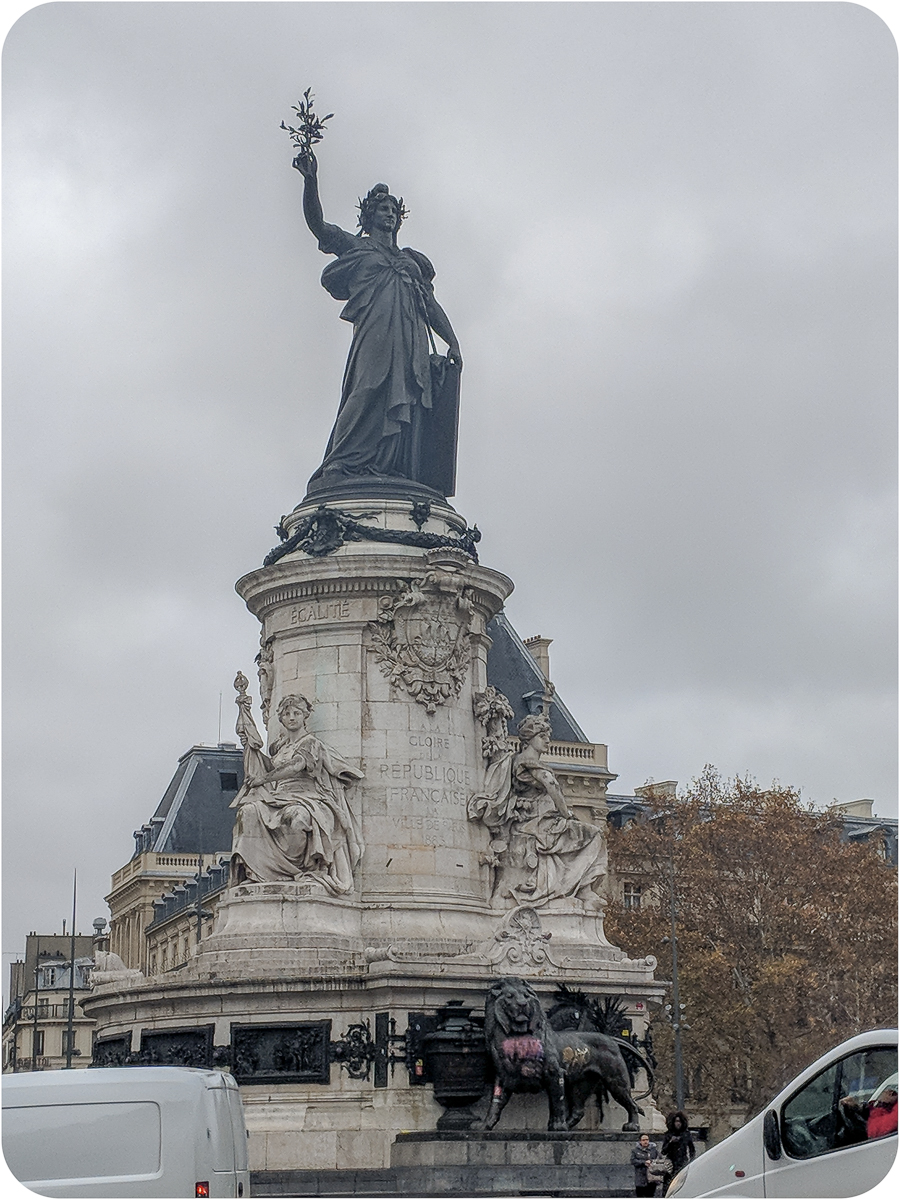 Place de la République, with a statue commemorating the French Revolution.
Place de la République, with a statue commemorating the French Revolution.
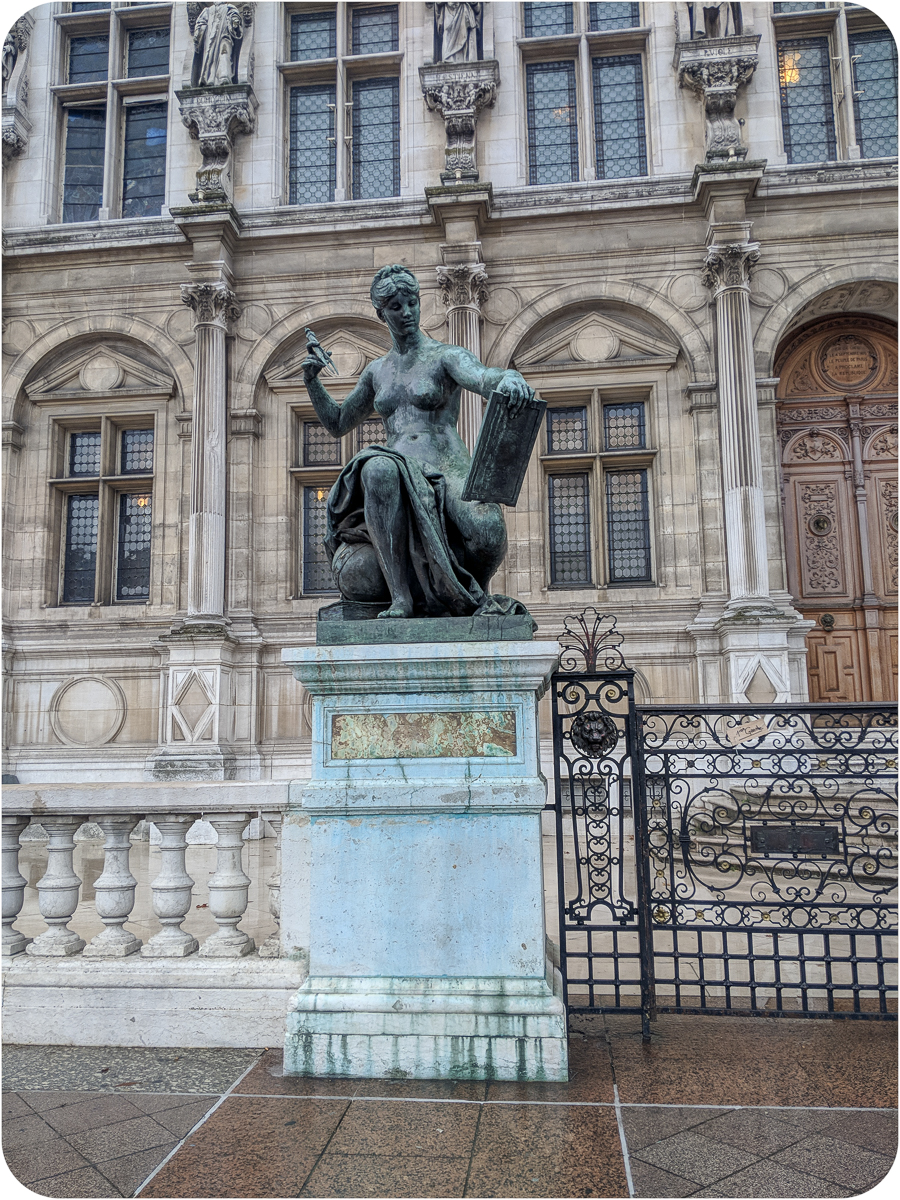 Science, Jules Blanchard, c. 1882
Science, Jules Blanchard, c. 1882
Before its closure, more than thirteen million people passed through the enormous wood and wrought iron doors at Notre Dame every year. People looking for absolution, people looking for peace, people looking for architecture, people looking for a medallion with the face of the Pope. It was the most visited monument in Paris by far, one of the most heavily toured monuments in Europe**.
This Gothic icon, built in the twelfth century, is so beloved now that it’s hard to believe that after the Napoleonic wars, it was almost demolished because it was in such a terrible state. Victor Hugo published Notre-Dame de Paris (better known as The Hunchback of Notre Dame) in 1831, which raised public awareness of its decay so that thirteen years later, “citizen-king” Louis Philippe I ordered that it be restored. (The same time period during which Les Miserables is set.)
Notre Dame took over twelve million francs to restore over twenty years. That restoration involved low quality stone and cement and even before the fire in April 2019, those restorations were starting to crumble, gargoyles cleaving from the structure to fall to the ground below, replaced with pvc pipe to drain water, the Catholic church (which permanently rents the building from the government of France, for free), not contributing nearly enough to its upkeep. Now, in the wake of the fire, it struggles more as people and businesses who vowed to donate to its restoration struggle to find their checkbooks as they already reaped the benefits of the public accolades and the news cycle has moved on. There are other practical concerns as well: how do you replace a roof made from an entire forest of trees when logging has all but eliminated the old-growth trees that would be large enough for such a project?
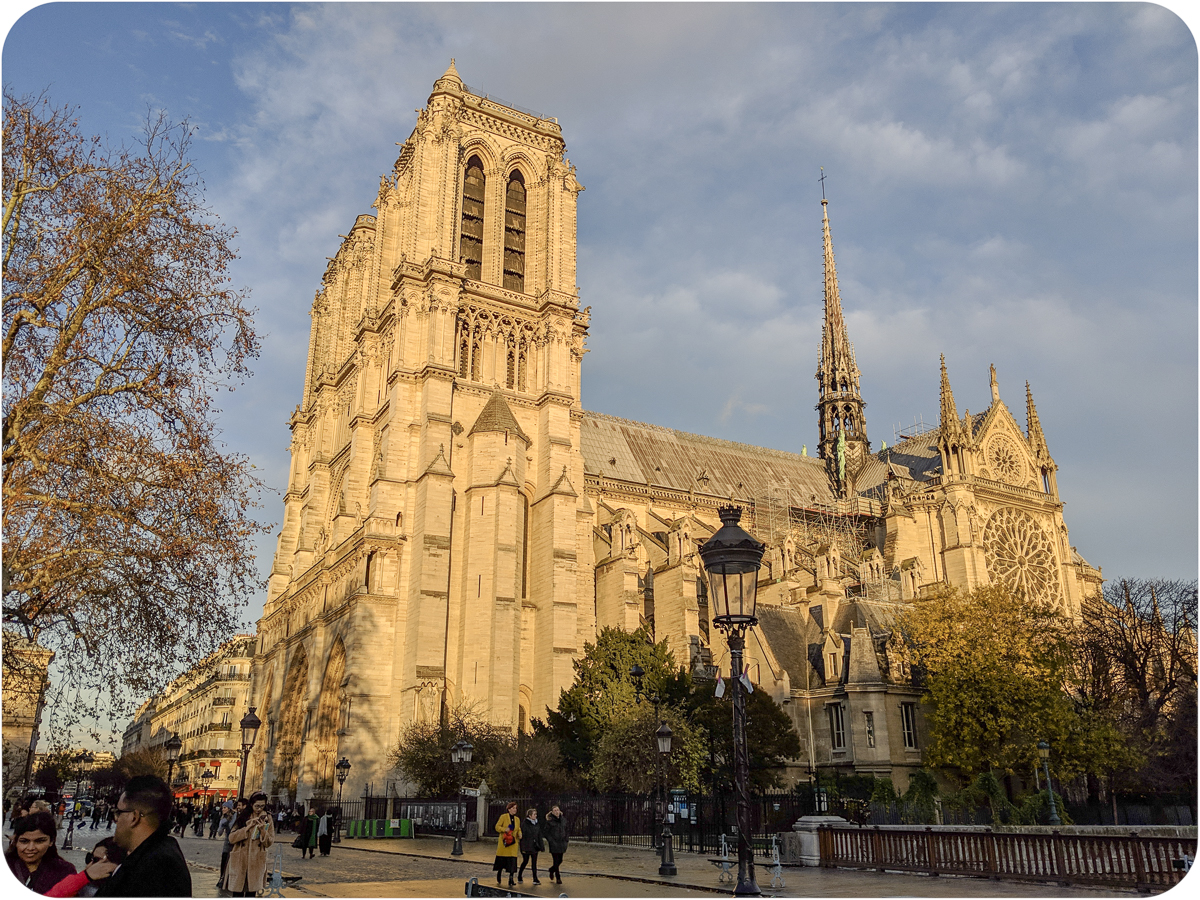 That teeny tiny little speck on top of the cross on the spire is a rooster as big as an average adult human torso, filled with religious relics.
That teeny tiny little speck on top of the cross on the spire is a rooster as big as an average adult human torso, filled with religious relics.
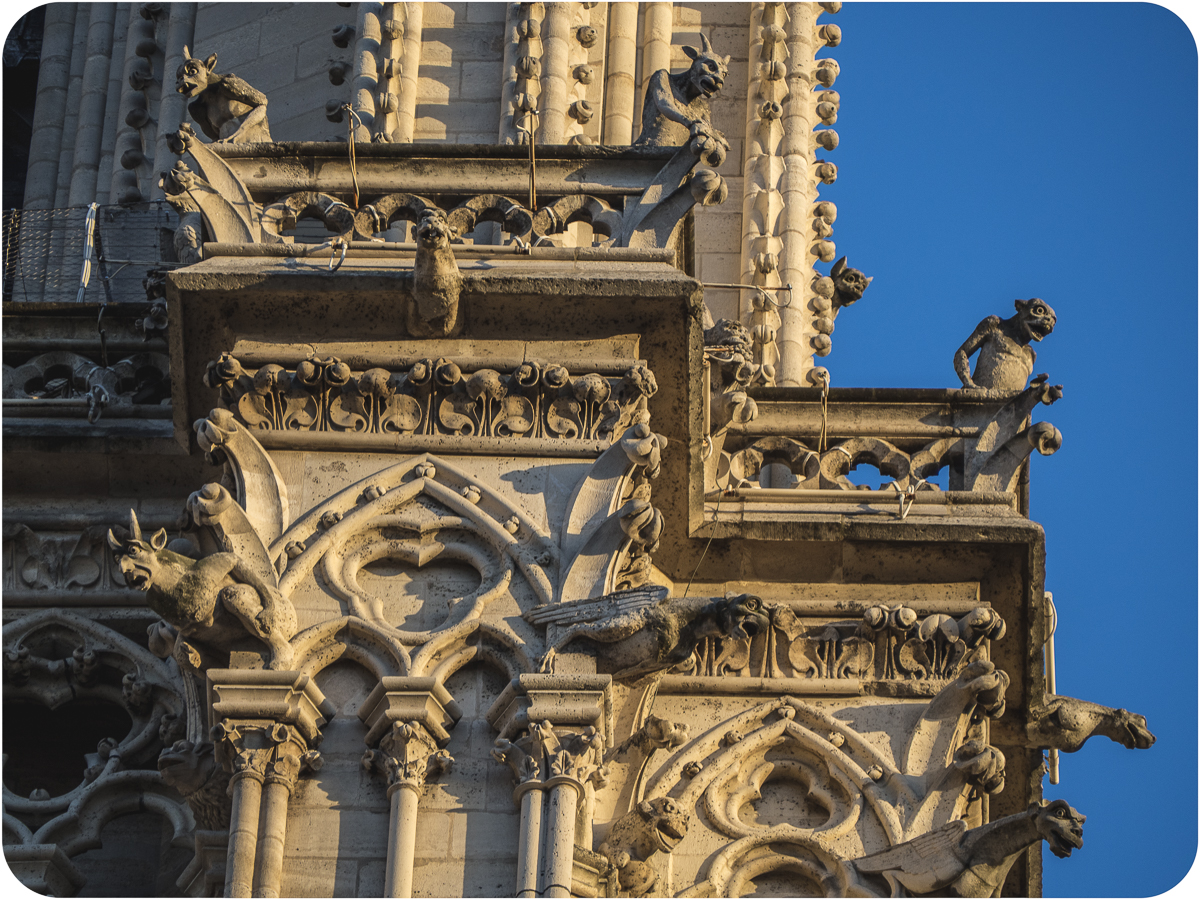 The gargoyles/grotesques were added in the 19th century, some 600 years after the cathedral was finished.
The gargoyles/grotesques were added in the 19th century, some 600 years after the cathedral was finished.
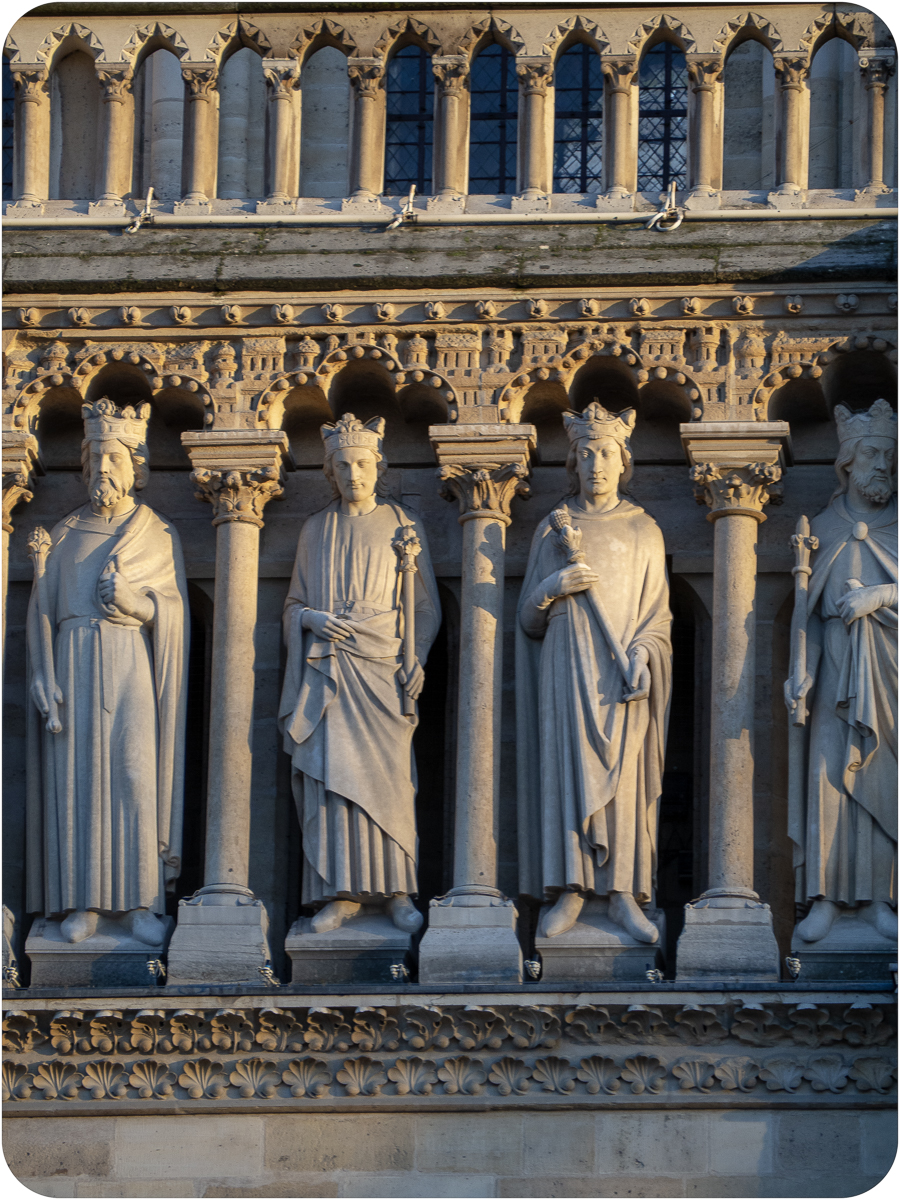 Most of these biblical kings were beheaded during the French Revolution in a frenzy of king beheading after Louis XVI only had but one to give his country and the crowd remained unsatisfied.
Most of these biblical kings were beheaded during the French Revolution in a frenzy of king beheading after Louis XVI only had but one to give his country and the crowd remained unsatisfied.
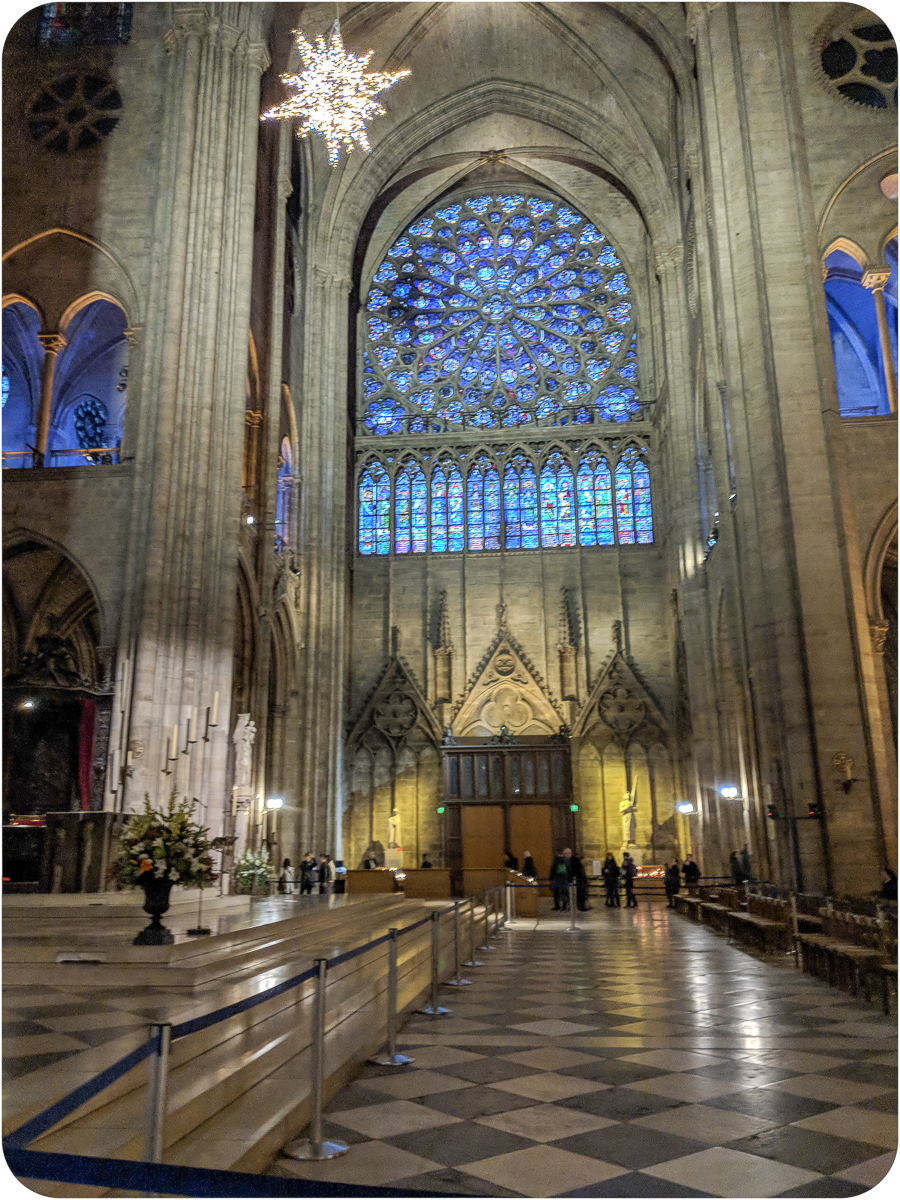 One of the rose windows, dates back to the 13th century; these survived the fire in April.
One of the rose windows, dates back to the 13th century; these survived the fire in April.
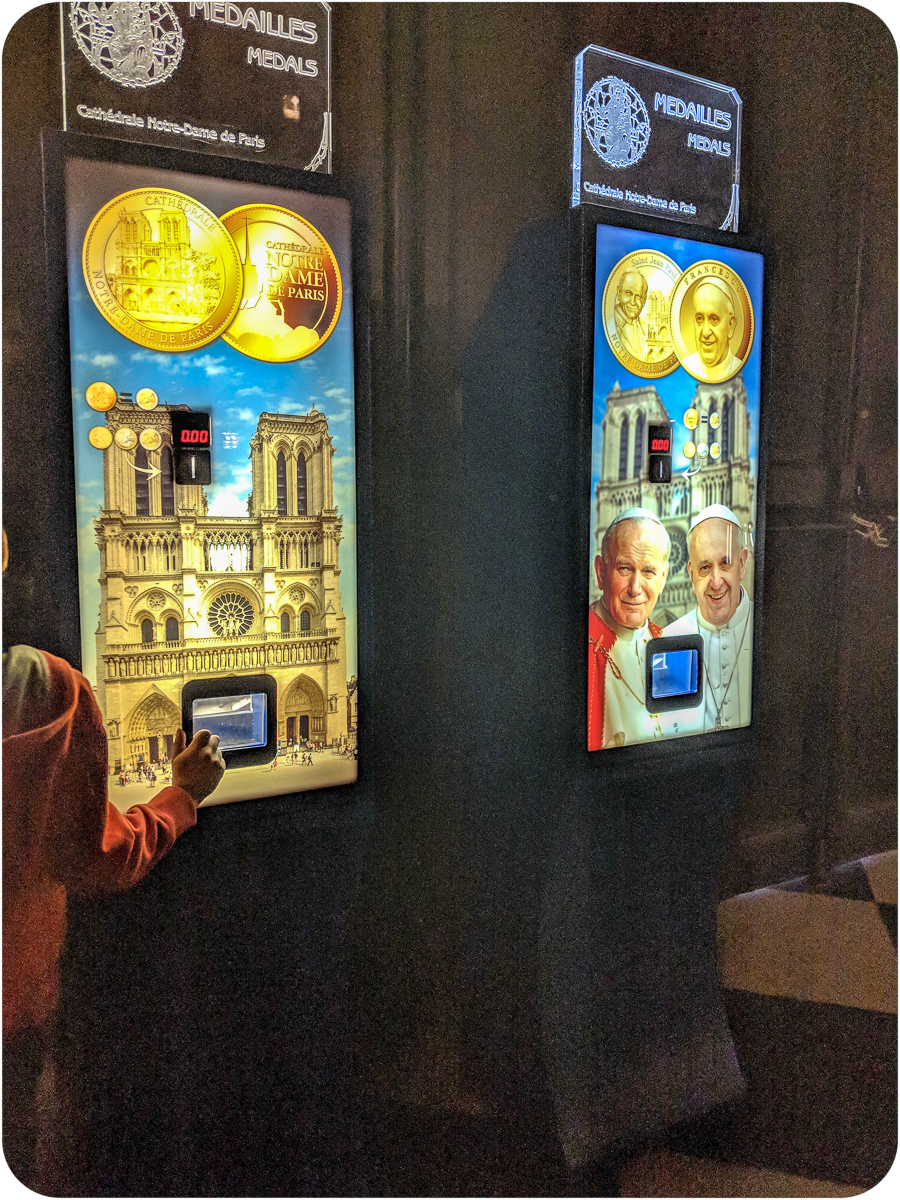 No word on whether these important relics were saved.
No word on whether these important relics were saved.
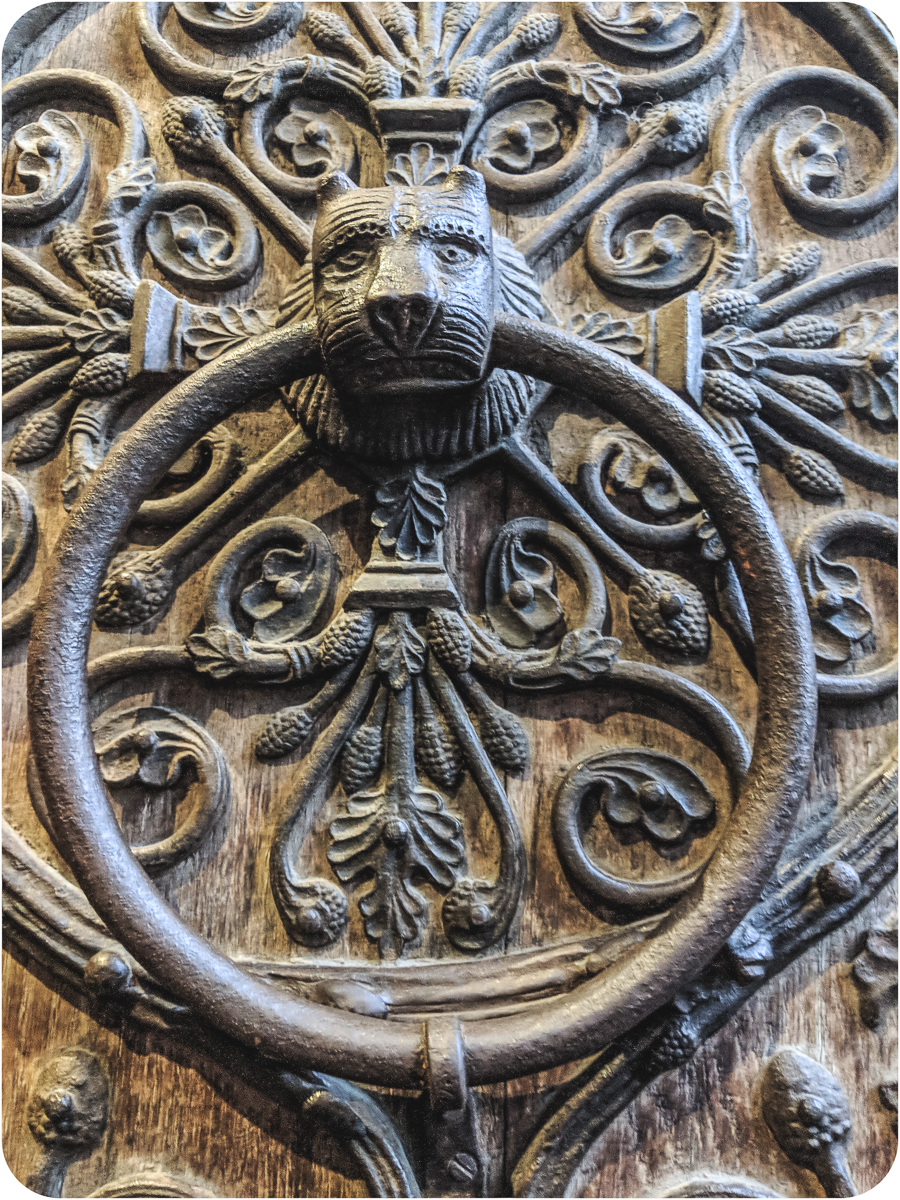 The doorknocker of Notre Dame; the 13th century wrought iron on these doors is so fine that a rumor began to spread that the blacksmith, Biscornet, had sold his soul to the devil for the ability to create them, because no one ever gets to be really talented at something without the credit going to someone above or way below.
The doorknocker of Notre Dame; the 13th century wrought iron on these doors is so fine that a rumor began to spread that the blacksmith, Biscornet, had sold his soul to the devil for the ability to create them, because no one ever gets to be really talented at something without the credit going to someone above or way below.
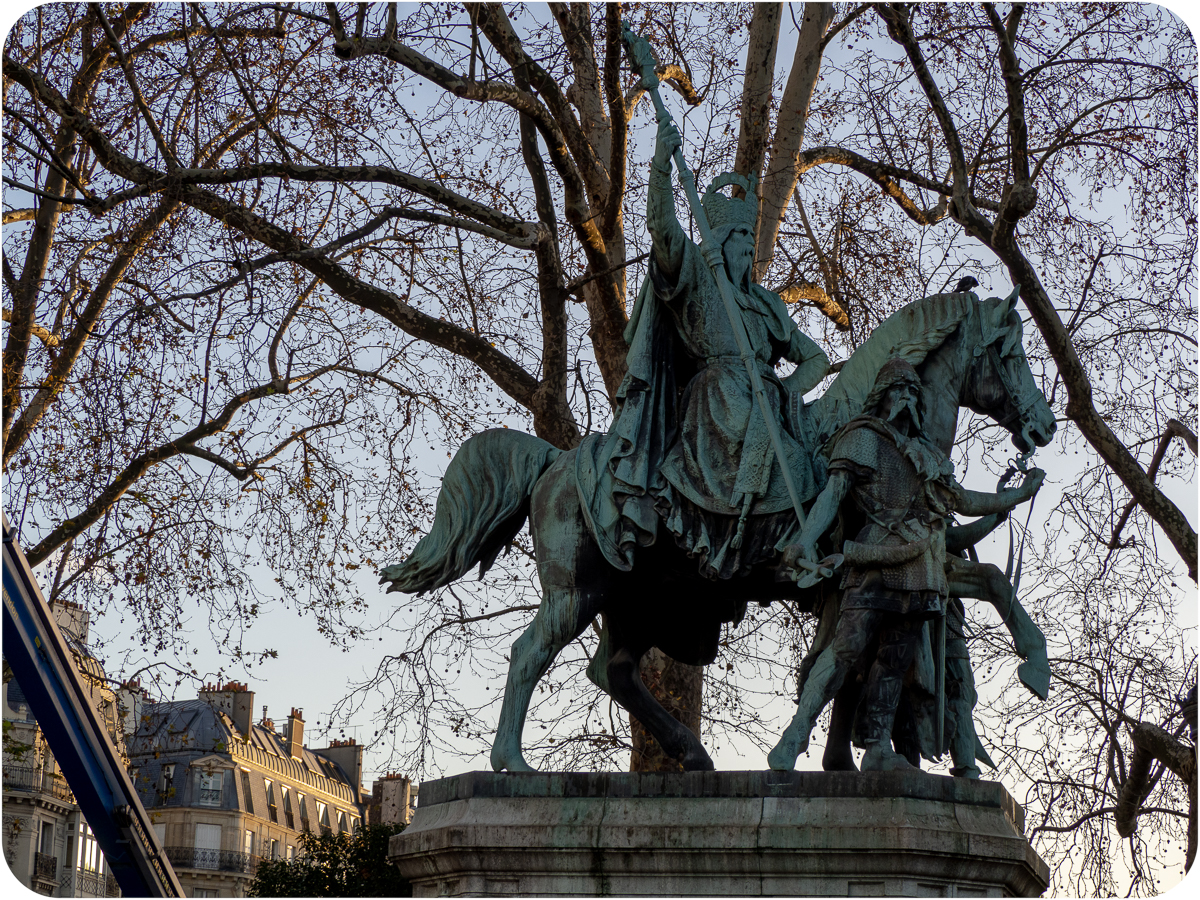 Charlemagne et ses Leudes / Charlemagne and his Guards. Charlemagne laid the first stone at Notre Dame and almost assuredly no others.
Charlemagne et ses Leudes / Charlemagne and his Guards. Charlemagne laid the first stone at Notre Dame and almost assuredly no others.
Our route took us down Rue Dante, a street with many shops of general nerd interest: toy stores, comic book shops, purveyors of pulp fiction, and a creperie with intergalactic decor named Odyssey that advertised in its window its right to refuse service to Jar Jar Binks. Our destination? The Musée de Cluny, Paris’ medieval history museum, constructed on the remnants of Gallo-Roman baths, rebuilt in 1510, and currently open to the public while undergoing a major renovation.
The entrance to the Musée de Cluny was not designed with modern security in mind but a conveyer belt x-ray machine and metal detector are wedged in there regardless. Personal belongings are funneled into an alcove with a narrow entrance, passable by one person. When it was my turn, I went in to grab my things, and an impatient older woman crammed in right behind me–she couldn’t get at her belongings, and I couldn’t get out. There was literally nowhere for me to go and she’s trying to reach around me with freaking zombie arms and I’d had just about enough of being physically forced around by other human beings all week and that’s the story of how I ended up snapping “MOVE” at an old lady because “pardon” and “excusez-moi” weren’t getting through. Because honestly? Have some spatial awareness. Consider the fact that other people exist. Good grief.
We were at the Musée de Cluny for their Magical Unicorns exhibit, along with what appeared to be every schoolchild in greater Paris. The Lady and the Unicorn tapestries, having just returned from Sydney, were the centerpiece, a set of six enormous red weavings whose meaning yet remains a subject of debate; the most likely theory in my estimation is the one that posits that the series of six tapestries is the five senses, plus one to grow on. In addition to the tapestries were some seventy other pieces related to the licorne from the museum’s collection, a common subject in medieval art, when it was believed to be a real animal.
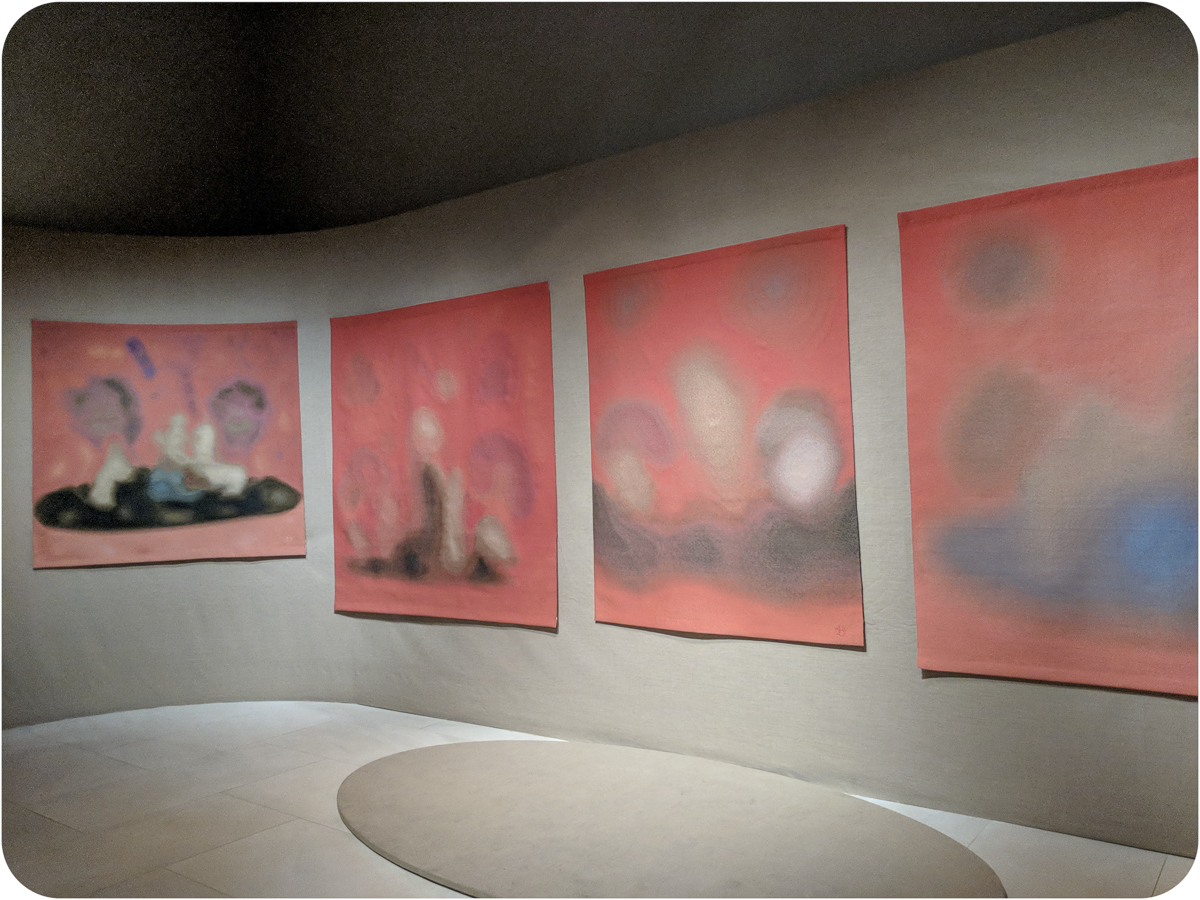 What the unicorn tapestries look like to people with undiagnosed myopia.
What the unicorn tapestries look like to people with undiagnosed myopia.
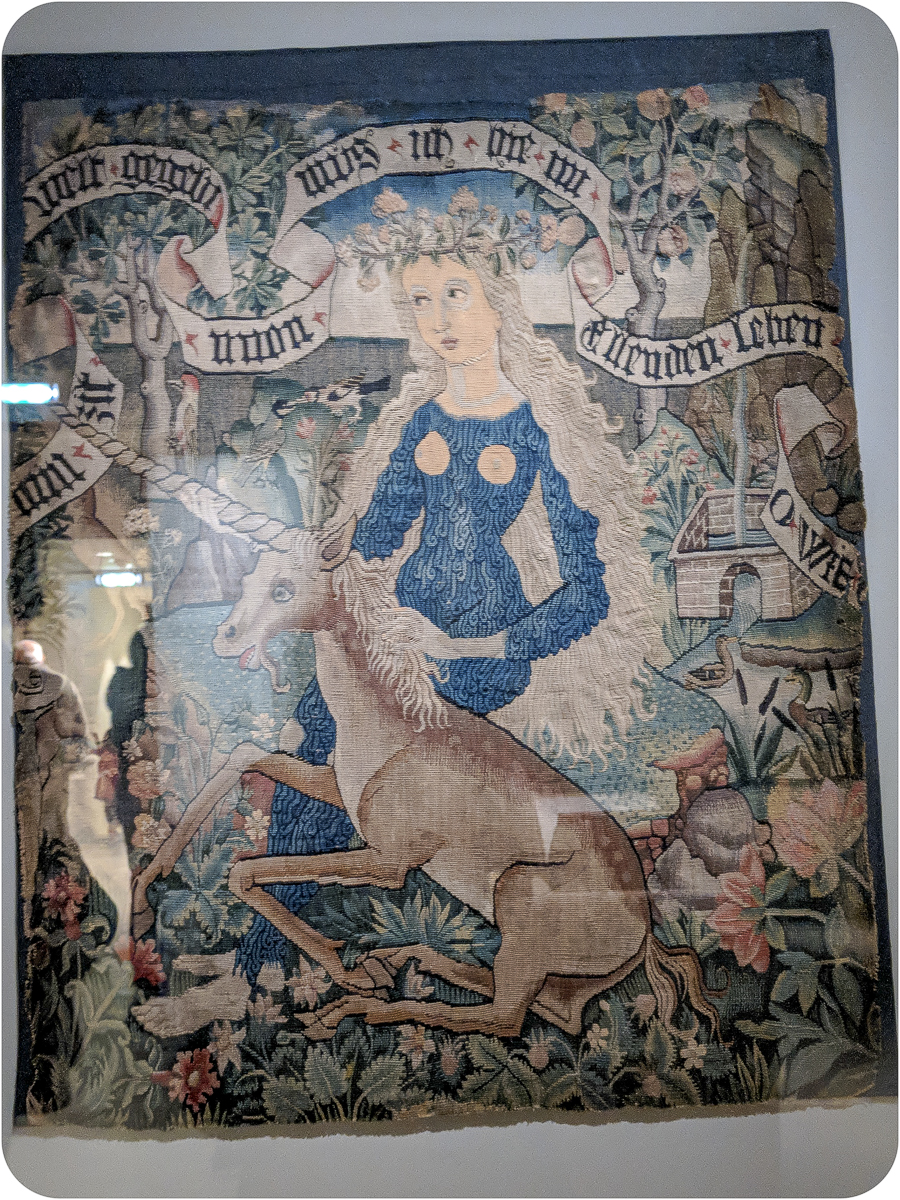 Wild Woman with Unicorn, a chairback cover from about 1500, her dress is not made of skink tongues but hair.
Wild Woman with Unicorn, a chairback cover from about 1500, her dress is not made of skink tongues but hair.
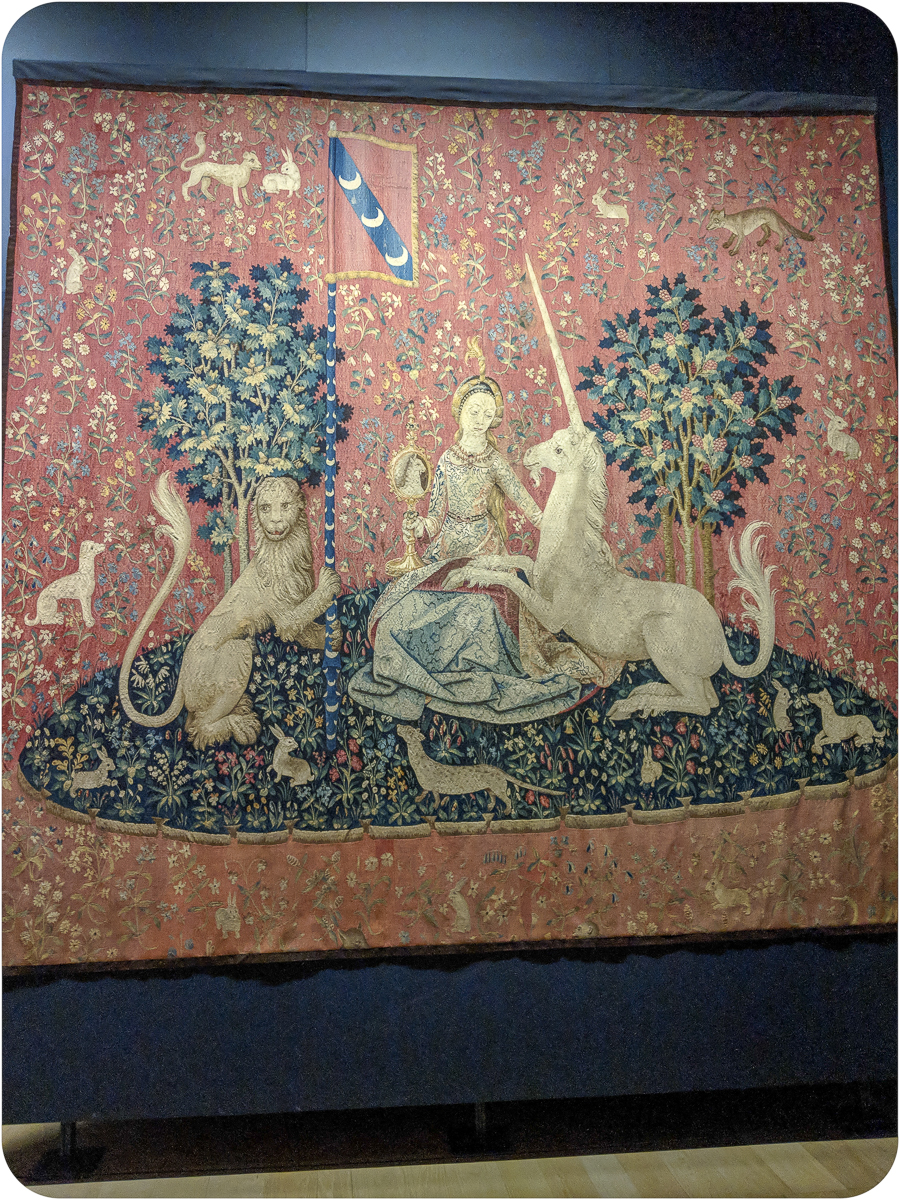 Sight, The Lady with the Unicorn
Sight, The Lady with the Unicorn
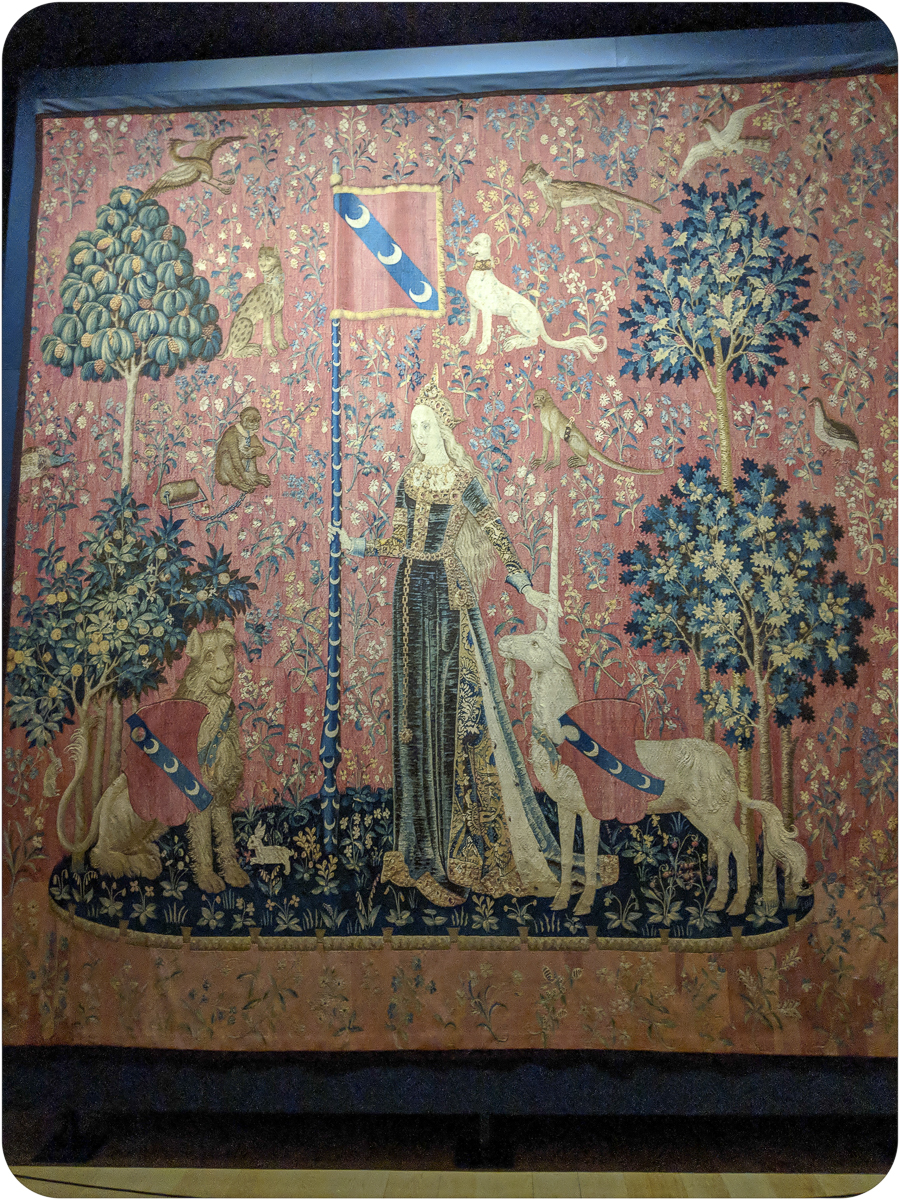 Touch, The Lady with the Unicorn
Touch, The Lady with the Unicorn
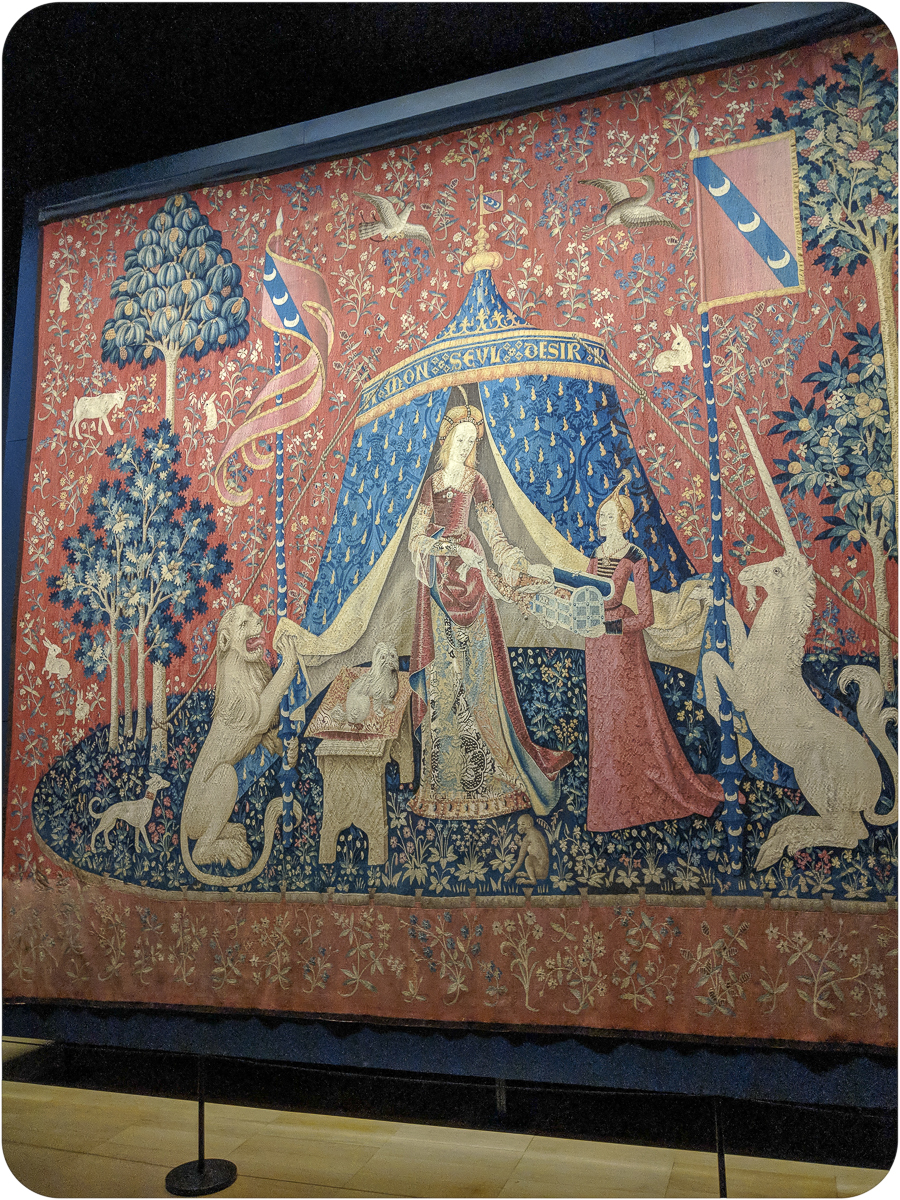 A Mon Seul Desir, the final tapestry in the Lady with the Unicorn series
A Mon Seul Desir, the final tapestry in the Lady with the Unicorn series
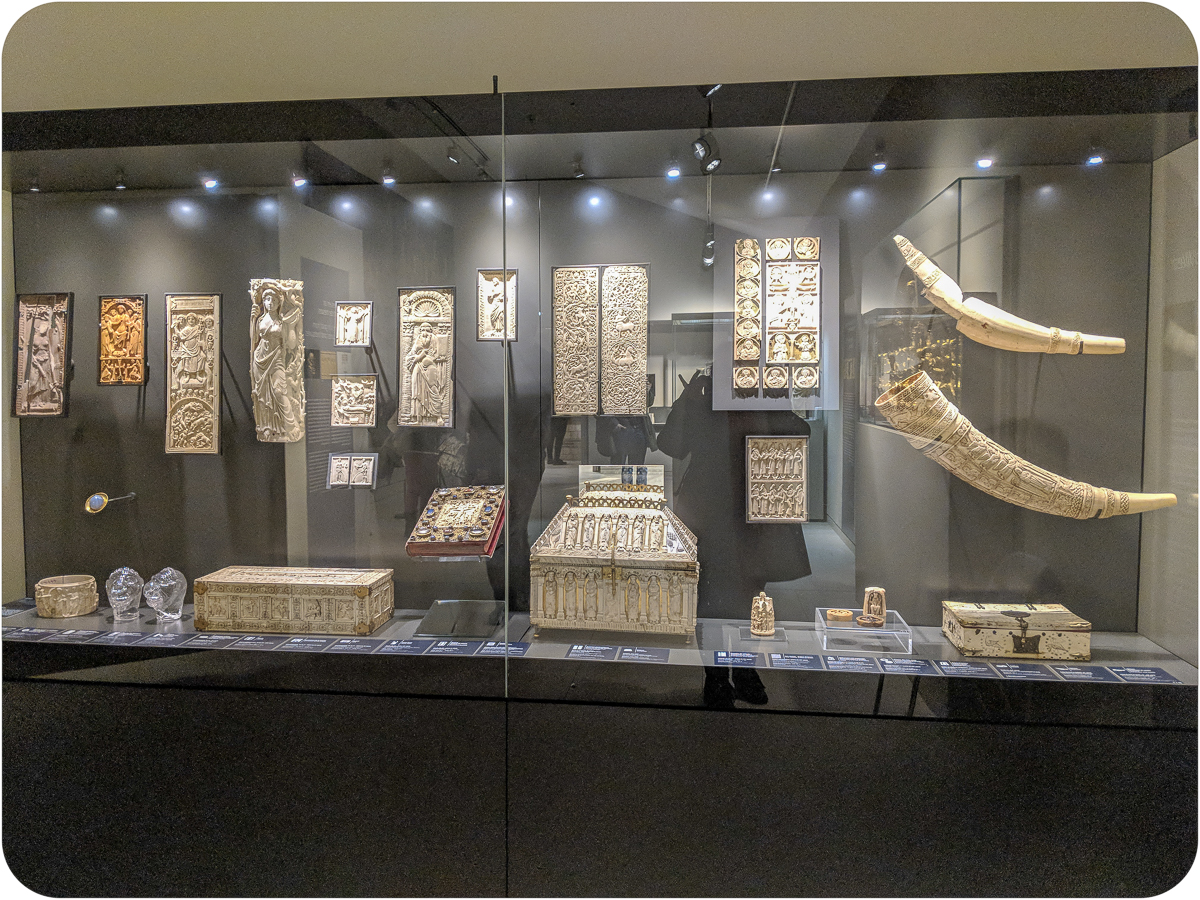 The only thought that went through my brain upon glancing at this display of ivory is “Look how many elephants had to die so we could collectively gaze upon more awful monk haircuts.”
The only thought that went through my brain upon glancing at this display of ivory is “Look how many elephants had to die so we could collectively gaze upon more awful monk haircuts.”
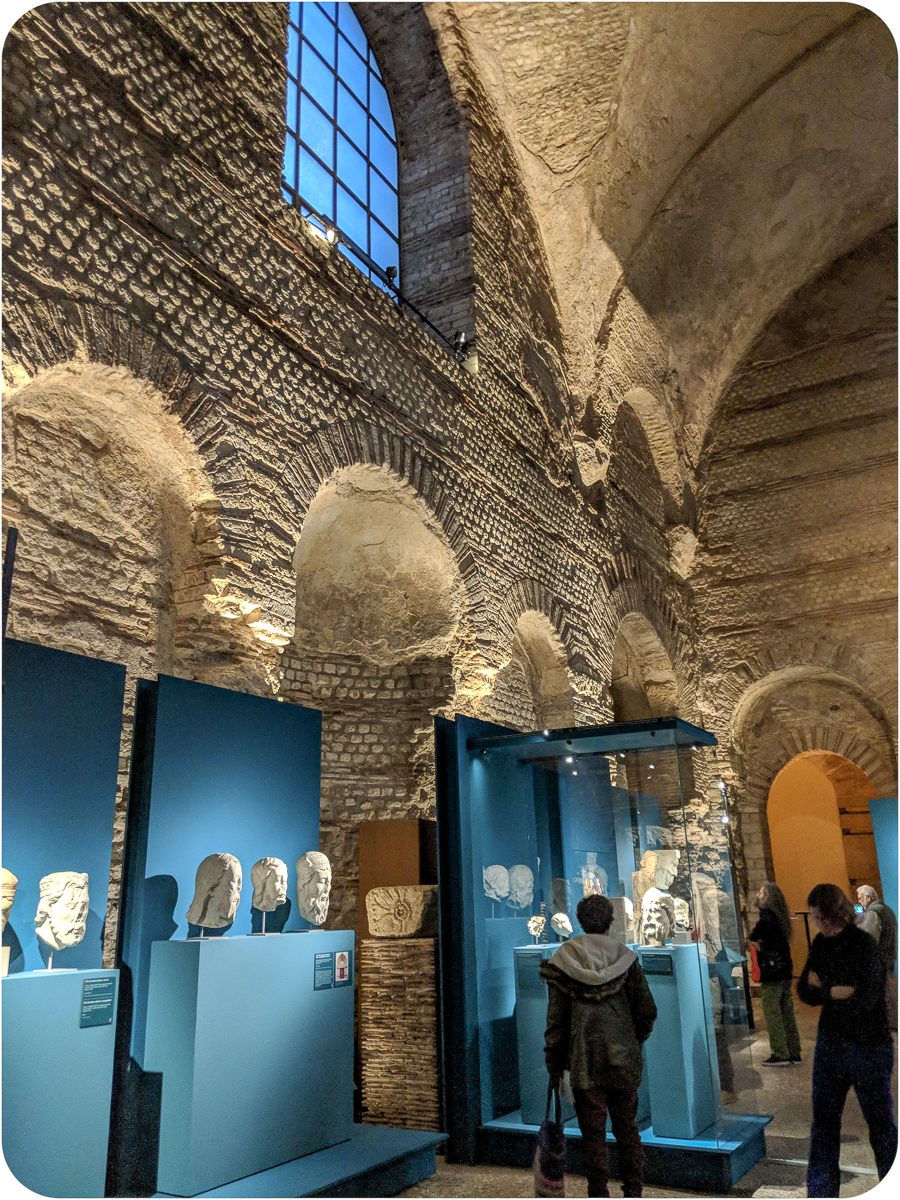 Some of the original heads of the biblical kings of Notre Dame that had been removed, discovered in 1977.
Some of the original heads of the biblical kings of Notre Dame that had been removed, discovered in 1977.
This spectacular chocolate death mask of Tutankhamun lured me into Maison Georges Larnicol though I didn’t end up buying any actual chocolate, leaving with an array of “kouignettes” and an obscene amount of tender, buttery salted caramels, both in assorted flavors . These mini kouign amann up the ante for richness. It’s the kougin amann equivalent of eating the center out of a cinnamon roll: the densest, softest part, with the highest ratio of filling to dough, except instead of cinnamon sugar, it’s a sticky-crunchy caramel swirled with raspberry, Grand Marnier, pistachio, or chocolate ganache. Given the abundance of butter, their petite size is just right. Their caramels are the best caramels I’ve ever eaten, with flavors like apple crumble, mirabelle plum, and sesame.
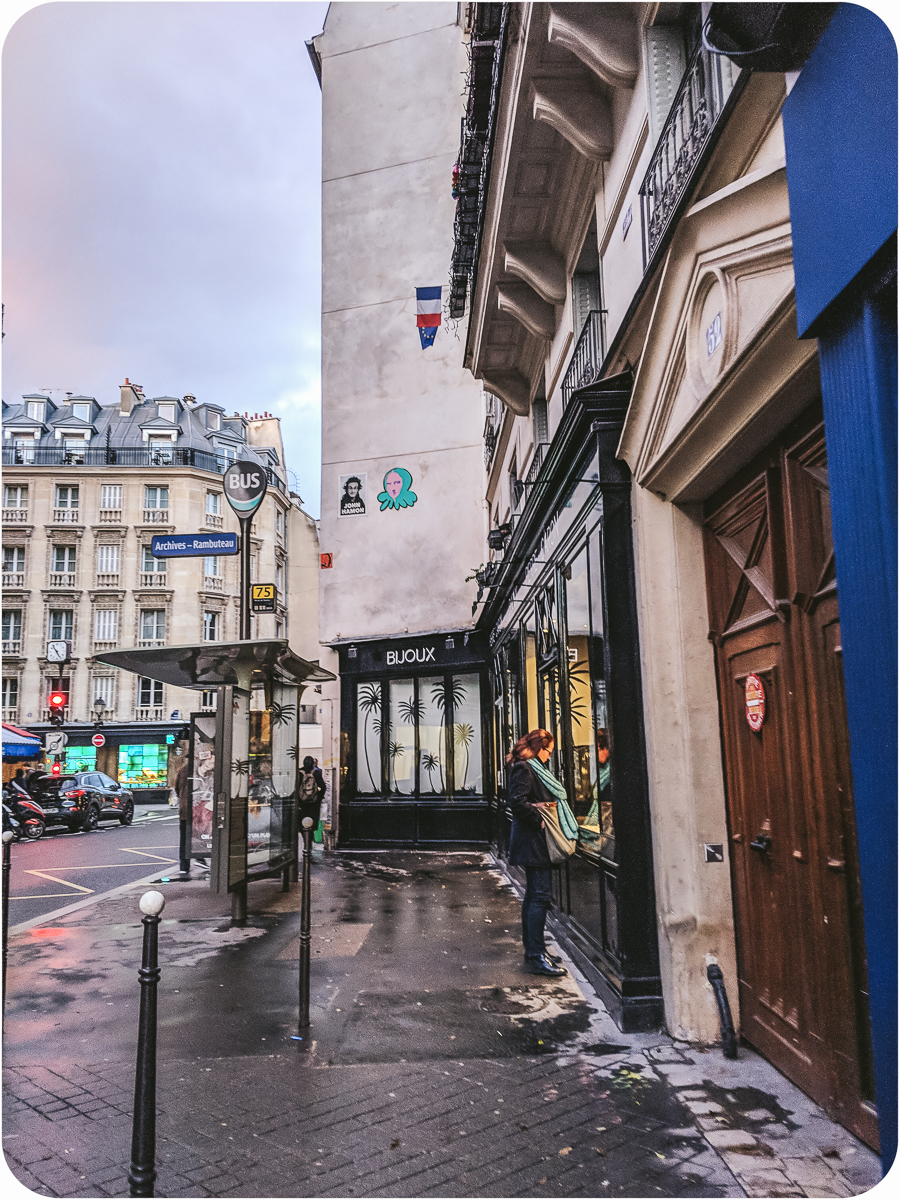 The French term for “window shopping” is léche-vitrine, or window-licker.
The French term for “window shopping” is léche-vitrine, or window-licker.
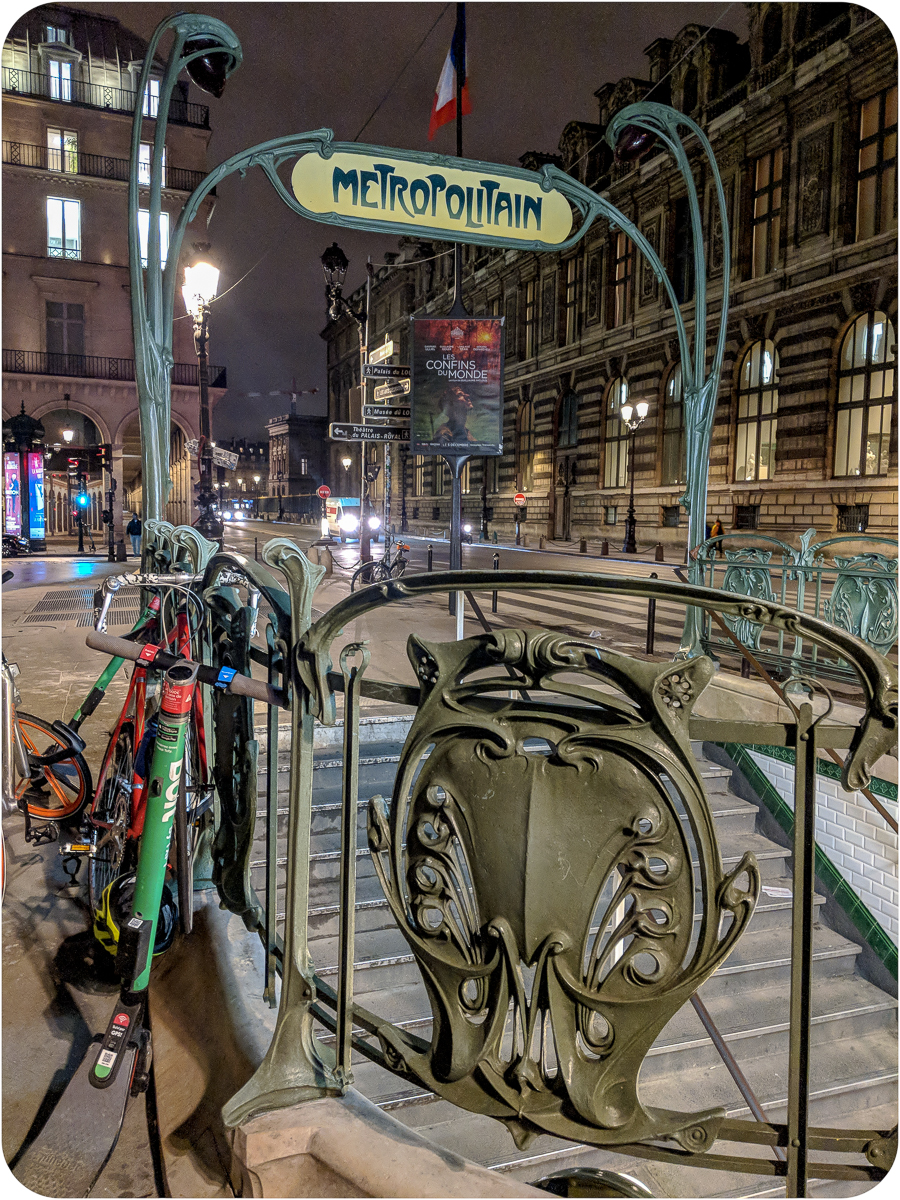 I’m not the biggest fan of the metro but I do love these swooping art nouveau entrances.
I’m not the biggest fan of the metro but I do love these swooping art nouveau entrances.
 Amorino Gelato, mango gelato with a mango Santa macaron
Amorino Gelato, mango gelato with a mango Santa macaron
We spent the rest of the day wandering around the city and snacking: croque monsieurs and frites, gelato, paprika chips…mmm, paprika chips.
* It was definitely a brush with bedbugs: I had six bites in a line from my upper arm to my elbow, and another four in a line on my opposite hip. The itch was so deep I could always feel the desire to scratch, over everything else. Since I never saw a physical bug and didn’t know until after I got home that I was bitten, this meant that I had to assume that my entire home was contaminated. Our luggage was garbage bagged and exiled. Our mattress was encased in plastic. Every single textile was laundered on super hot regardless of the care instructions and then quarantined in garbage bags until the entire job was finished. We vacuumed and vacuumed and vacuumed. I canceled social engagements in case there was a chance I could spread them. I warned people before they attempted to hug me. (That part was the hardest, feeling like the kind of dirty that can’t be cleaned with the people whom I most enjoy having that kind of closeness, which makes sense because it’s not like you’re often given the opportunity to hug an enemy or even a frenemy to infest them, like a Kiss of Death except it just psychologically tortures them for weeks.) The pest control guy could not find any evidence of bedbugs in our home (see: all the cleaning) but set some traps with bedbug lures which have never caught a single bedbug. I haven’t had any bites appear since and I have to conclude that I was bitten and either didn’t carry any home with me or that my quarantine and extermination efforts did the trick. Do I still feel uneasy any time I feel the faintest tickle on my body in the night? Damn right I do.
**Let’s be real, though: Notre Dame is smack in the middle of Paris, on an island in the Seine which splits the city in two, so it is in the primest of locations for foot traffic. If every time we walked by was a “visit”, Jason and I visited Notre Dame about twelve times.

